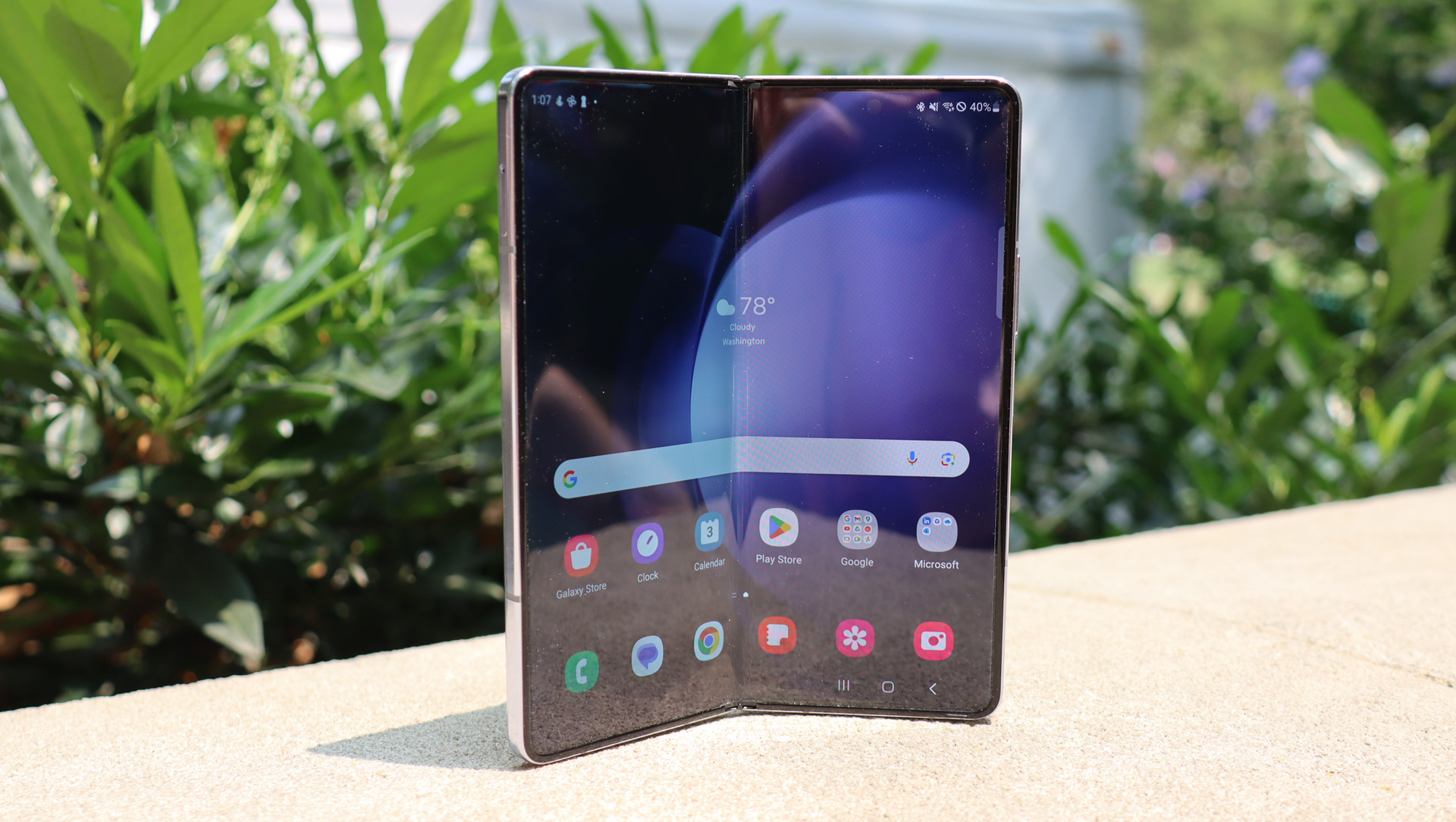
Samsung Galaxy Z Fold 5: Two-minute review
I'm pleased with virtually everything Samsung has done to its premiere foldable – the Samsung Galaxy Z Fold 5 – to make it a better mobile productivity companion than its predecessor.
A flat-folding phone that is noticeably thinner and lighter than Galaxy Z Fold 4 is the kind of change we want in foldable development. Sure, the Google Pixel Fold (not to mention a handful of the other best foldable phones out there) beat it to the punch, but at least the Z Fold 5 is 30 grams lighter than its chief adversary.
We wanted faster and we got it, with the 'Qualcomm Snapdragon 8 Gen 2 Mobile Platform for Samsung', the best chip Samsung is using across all of its new top-tier phones.
On the other hand, what frustrates me are the omissions and tough, but probably necessary, design decisions. Samsung left the camera hardware from the Z Fold 4 untouched. Even that lackluster 4MP under-display camera on the main display is still there. I understand that the main camera array is an above-average collection of sensors, but they're now falling behind the competition, because that competition is primarily from the Google Pixel Fold. I don't understand why Samsung didn't just take the powerful rear camera array from the Galaxy S23 Ultra and slap it on here. Okay, okay, I probably do know. That 10x periscopic optical zoom camera would almost certainly have increased the thickness of one side of this folding handset, just as Samsung managed to slim it down.
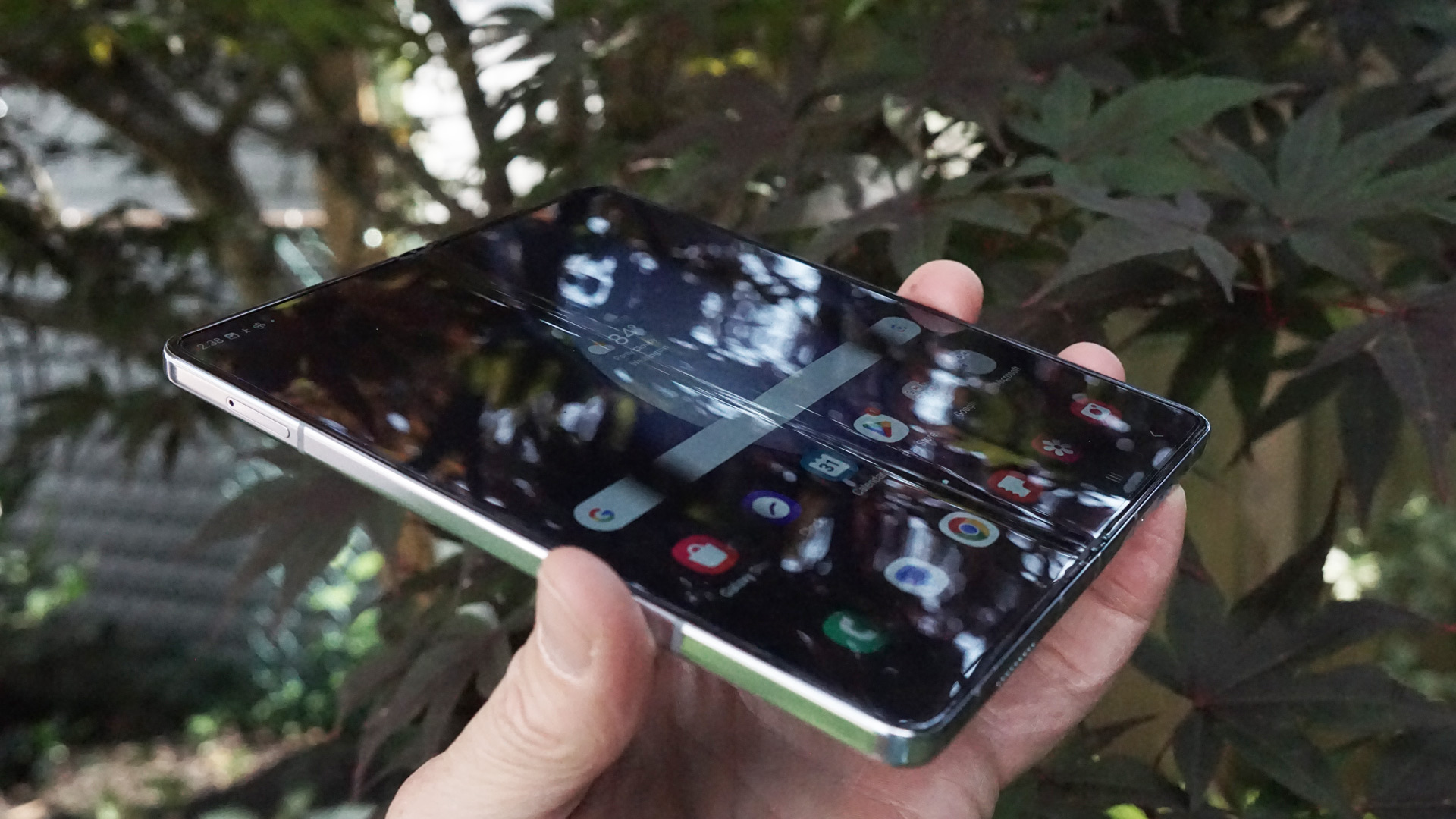
Samsung is charging $1,799.99 / £1,749 / AU$2,599 for the Galaxy Z Fold 5 and will tout its ability to work with the custom (and now thinner) S Pen, but the pen is not included in that substantial price. That, as far as I'm concerned, is a mistake.
Finally, as much as I love the flexible 7.6-inch display and appreciated the widening of the cover screen with the Galaxy Z Fold 4, I'm realizing that the narrow 6.2-inch display on the Galaxy Z Fold 5 is insufficient for real-world productivity. Again, I came to this realization after using the Google Pixel Fold's much wider-aspect ratio 5.8-inch cover display. Samsung considered making the Z Fold 5 wider but ultimately did nothing to the screen aspect ratio or display technology between generations.
I don't discount this screen as a camera viewfinder, a content browser, and social media reader, but typing on it is not good. The keys are too cramped and I often mistyped. Worse, in some apps the keyboard sits right on top of the on-screen home button, and more than once I popped out of an app because I hit that instead of a key.
Despite all this, I'm still a Galaxy Z Fold 5 fan. It is fun to hold and use, takes nice, if over-vibrant photos, and is about as peppy as a handset can get. If this is your first Fold, it's a winning choice; if you already own a Galaxy Z Fold 4, hold onto it and wait for the Z Fold 6.
Samsung Galaxy Z Fold 5 review: Price and availability
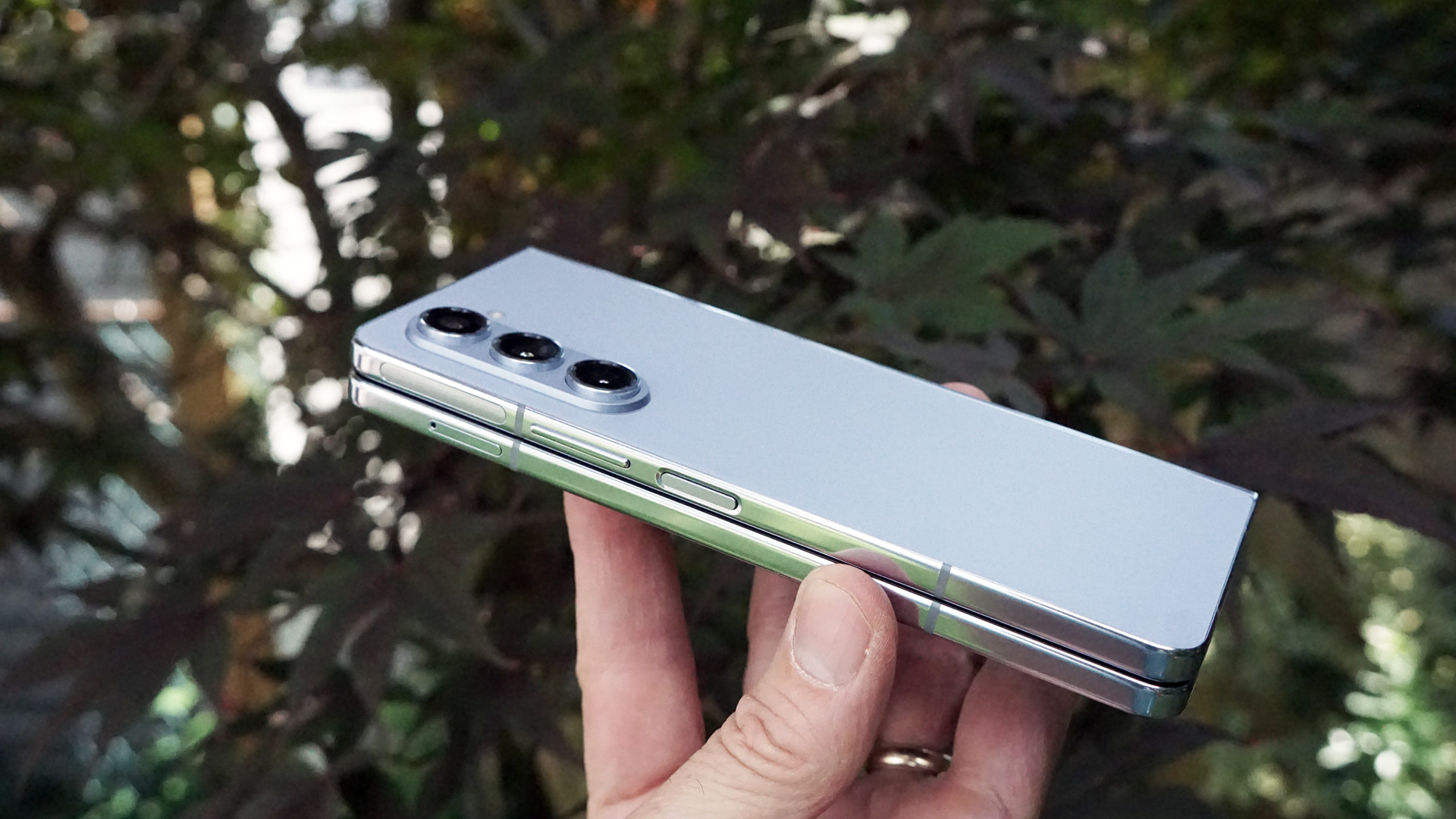
- Starts at $1,799.99 / £1,749 / AU$2,599
- No price increase in the US
- Shame the price doesn't include the compatible S Pen
- A narrow smartphone and mini tablet for the price of one device
Samsung launched the Samsung Galaxy Z Fold 5, along with the Galaxy Z Flip 5, Galaxy Watch 6, Watch 6 Classic, and a collection of Galaxy Tab S9 tablets, on July 26 during its South Korea-based Samsung Unpacked event. It's available for pre-order now, and ships August 11. You'll find the best prices and offers in our Galaxy Z Fold 5 deals roundup.
At $1,799.99 / £1,749 / AU$2,599, the Galaxy Z Fold 5 is among the most expensive smartphones on the market. Even a 1TB iPhone 14 Pro Max will cost you less at $1,599 / £1,740 / AU$2,769. But then that's just one phone with one excellent screen. The Galaxy Z Fold 5 is a two-in-one device, with a lovely 6.2-inch screen on the outside and a precision-engineered 7.6-inch flexible screen on the inside. If that doesn't scream "premium" to you, then maybe its five cameras will convince you.
If that US price sounds familiar to US readers, it's because it's the same as last year, and that's good news. This is not the exact same phone; it's flatter and faster. It's essentially a free upgrade.
It's a shame that Samsung can't manage to bundle the compatible S Pen into that price though. It's a lot of fun to use on the Z Fold 5's main display and elevates the utility, so why not show people what they're missing by making it part of the price?
In any case, those prices will ultimately be only a suggestion; there are deals and trade-ins that cut the price by as much as half. Essentially, no one should be paying full price for this smartphone.
- Value score: 4 / 5
Samsung Galaxy Z Fold 5 review: Design
- Thinner and noticeably lighter
- No gap, folds flat
- Quality materials
- A good size mini-tablet when open but too narrow a phone when closed
The Samsung Galaxy Z Fold 5 design has all the earmarks of an iterative update. At a glance, it looks quite similar to the Galaxy Z Fold 4 but there are important and, to my mind, welcome differences.
This is a much lighter phone, dropping roughly 11 grams over the previous model. It's also (at 252 grams) 30 grams lighter than the hefty but excellent Google Pixel Fold (282 grams). More importantly, the polished aluminum and Gorilla Glass Victus 2 (reportedly 25% strong than the Fold 4's Victus Plus) glass-covered frame now folds flat. That, in combination with the millimeter of thickness Samsung carved off the body gives you – when folded – a much thinner and lighter device. It is a pleasure to hold.
To make the tighter fold possible, Samsung reengineered the hinge and how the flexible display is curved inside it when you close the phone. The hinge mechanism's sweeping technology introduced a few years ago to keep out dust and crumbs is still there, though.
That new hinge appears to have made the flexible display crease ever-so-slightly less noticeable. You can still see and feel it but I'd swear it's a bit less pronounced.
Button and port placement are mostly the same. There are speaker grills on the top and bottom edge of the phone that are slightly smaller than they were on the Z Fold 4, and a USB-C port on the bottom next to a microphone port. On the top are a pair of microphones and one air vent. There's a physical SIM slot on the left edge (if the handset is open with the Main screen facing you), and power/fingerprint reader and volume rocker buttons on the right.
The fingerprint reader, by the way, is one of a pair of effective biometric security options. You can register your face to unlock or use the fingerprint reader. I had no trouble registering a digit and my face to unlock the phone.
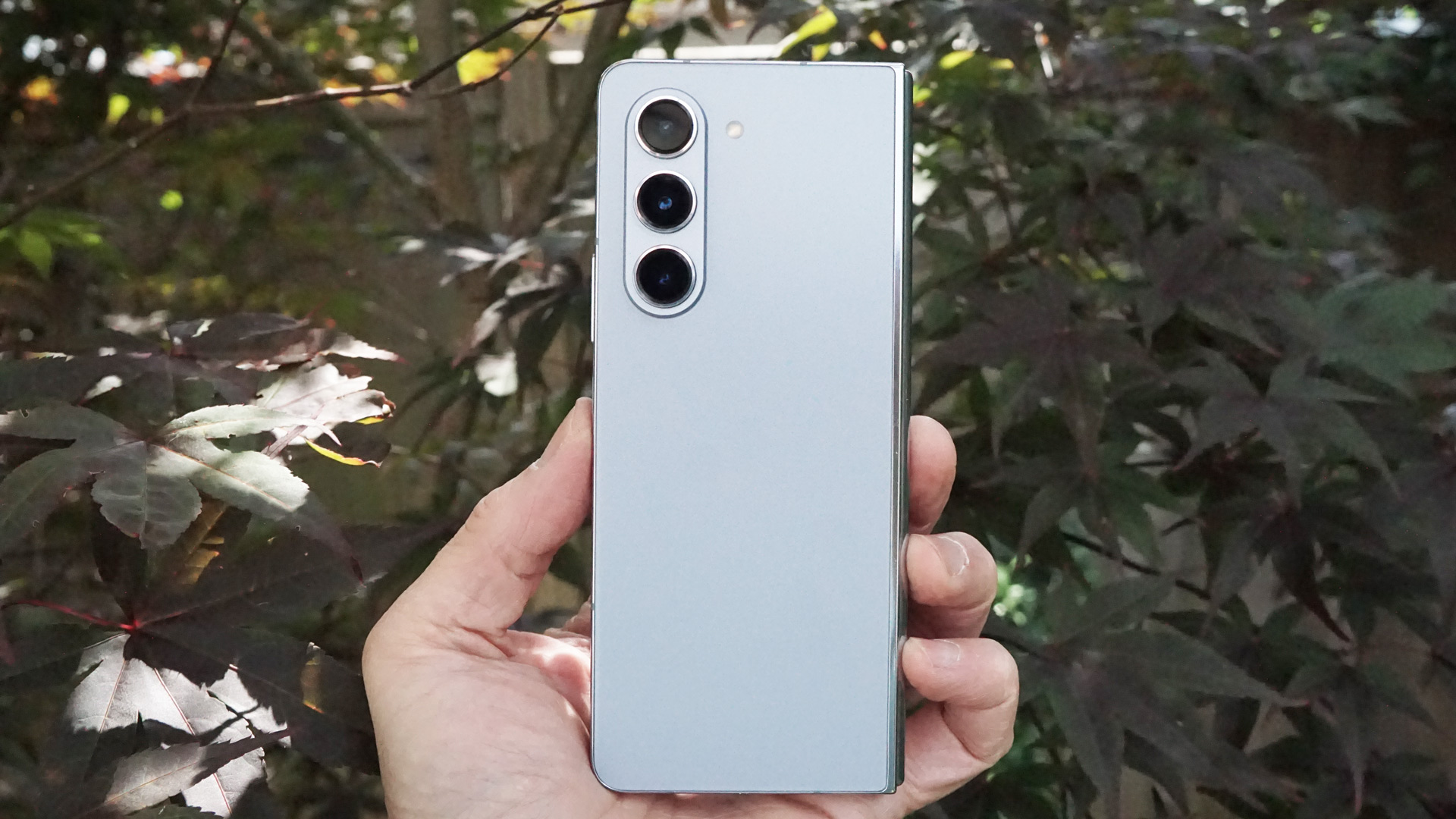
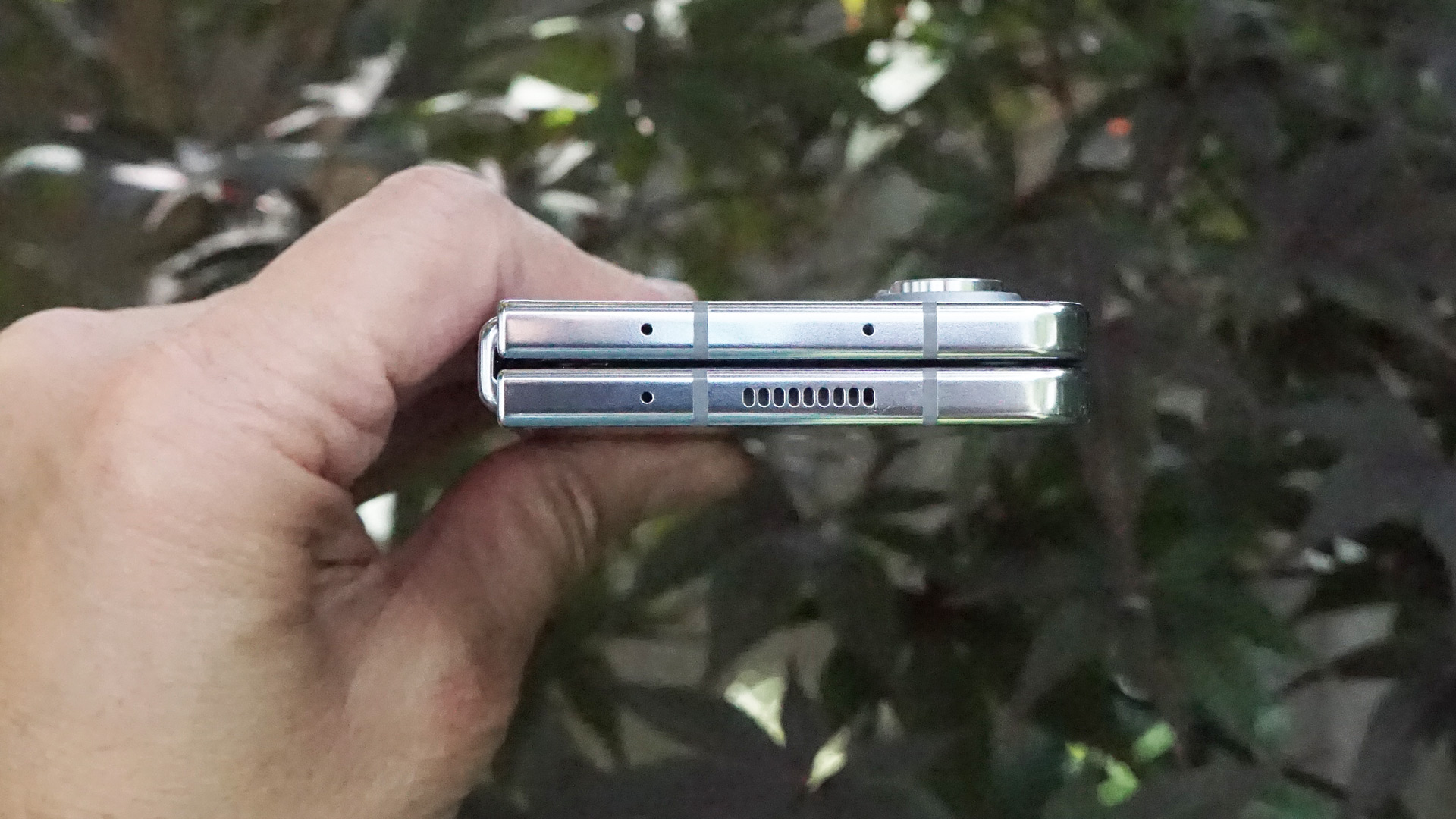

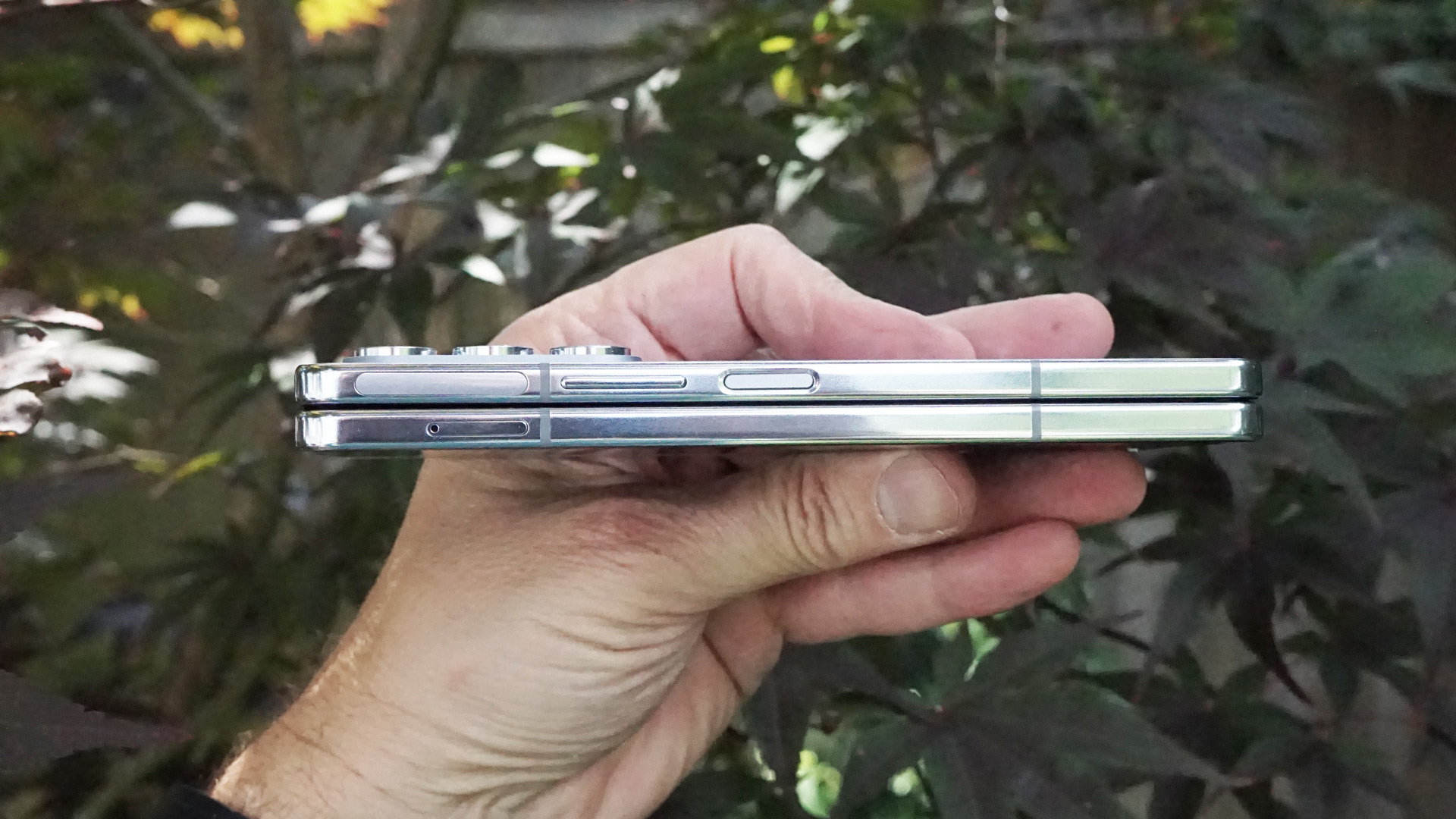
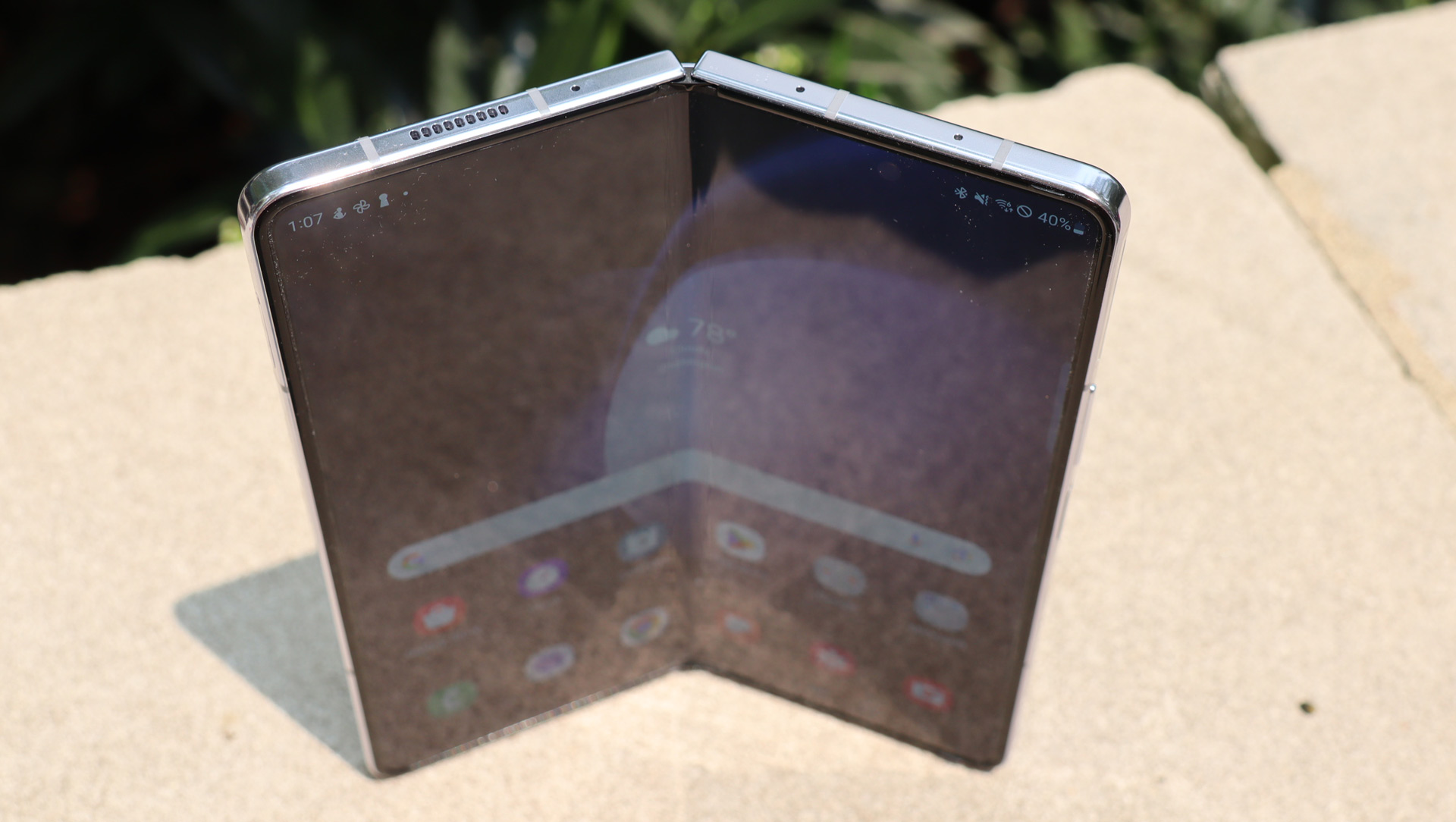
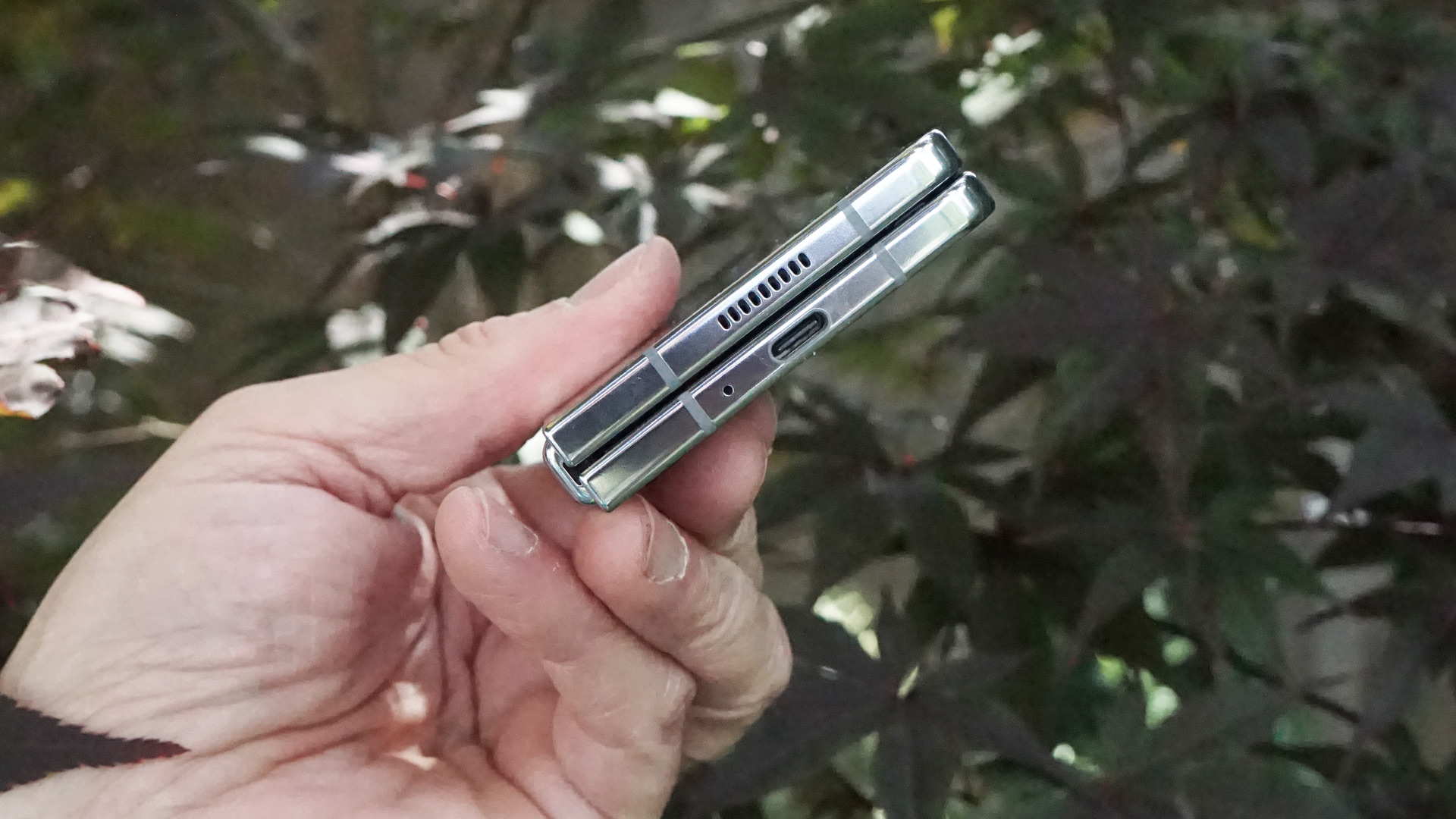
Even though the cameras – all five of them – are unchanged in terms of hardware from the Z Fold 4, there is a subtle visual tweak to the rear camera array. It looks like Samsung shaved off some metal from the aluminum island surrounding the three rear lenses. In addition, they've moved the LED flash out of the island and placed it next to the lens array.
Otherwise, everything is the same. I liked the last design and appreciated that Samsung managed to make the cover screen slightly wider without enlarging the phone chassis, compared to the Fold 3. But that was before I used the Google Pixel Fold. Even though Google also has a 7.6-inch flexible main screen, when opened flat, it's wider than it is tall. As a result, the Pixel Fold's 5.8-inch cover screen adopts a far more squat aspect ratio compared to the Fold's, which is is arguably far more functional and better suited to modern smartphone apps and interface design.
However, when I open up the Z Fold 5, I quickly notice the edge-to-edge screen. It seems larger than what I find on the Pixel Fold, where Google chose to leave a significant bezel to accommodate its internal front-facing camera. Samsung's main camera is craftily hidden underneath the main folding display and only appears as a cut-out when you use it.
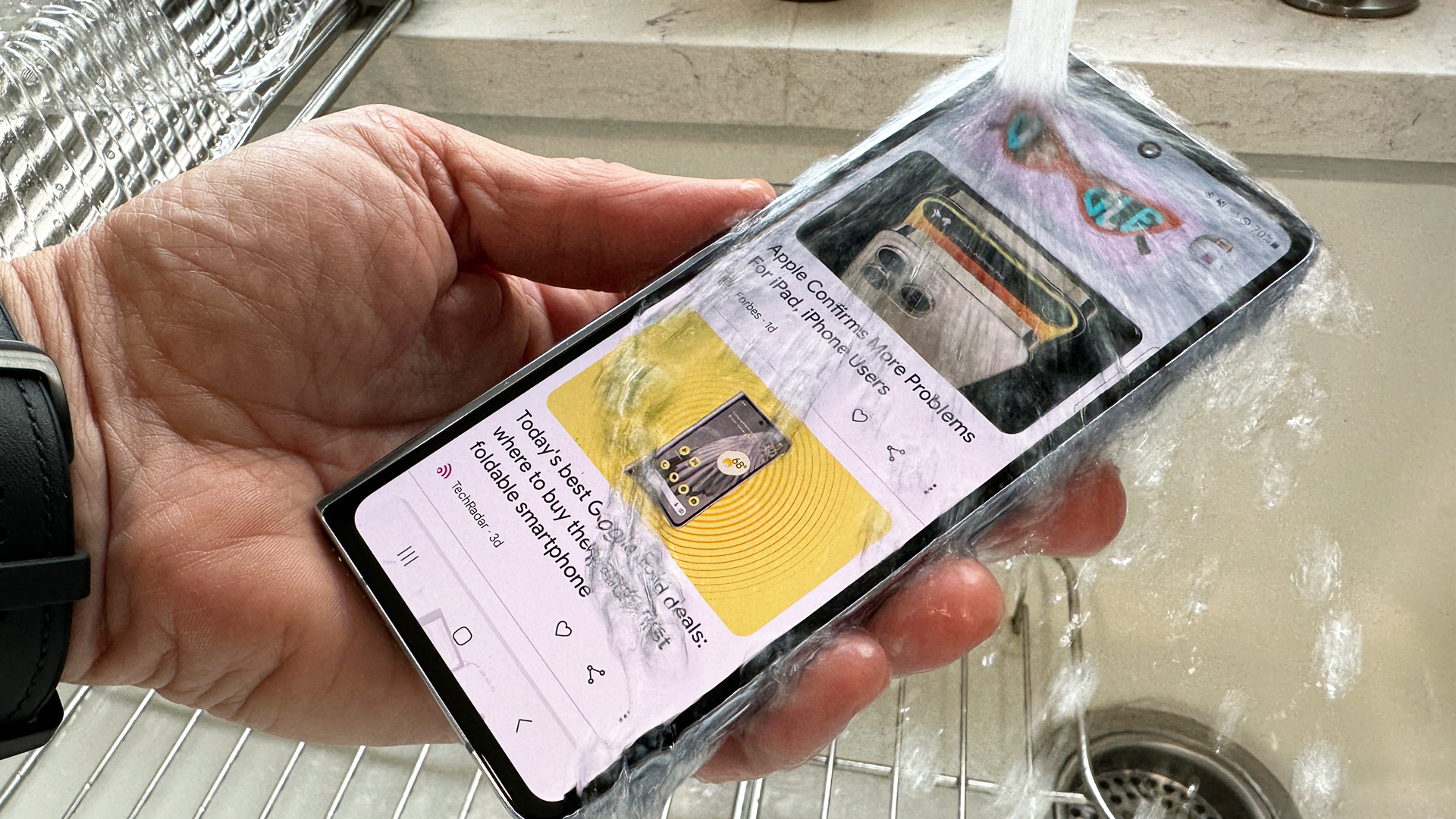
Samsung's overall flexible screen protection appears better thought out than Google's. On the Pixel, there's a noticeable space between the protective cover and the flat, black plastic edge surrounding the flexible display. Samsung keeps that dust-catcher tighter and also includes a raised black plastic edge around the screen, plus a couple of rubber bumpers to prevent you from slamming the phone shut and damaging the display.
As for the hinge function, it's smooth and solid. I opened and closed the phone hundreds of times and it felt just as sure at the start as it does now, while I write this review. This is a well-built Android phone. In fact, having seen how Samsung builds its Galaxy products first-hand, I can say they are meticulous and do not suffer imperfections gladly.
From an aesthetic perspective, this is an attractive device, no question; the polished color-matched frame evoking the clasp of a designer handbag or briefcase. I have the Icy Blue colorway (my favorite and the signature finish of the Fold 5) but you can also get it in Phantom Black, Cream (from Samsung.com only), Gray, and Blue. When it's folded closed, you're looking at sandwiched, polished aluminum, colored glass on the rear, and a tall cover screen. It feels solid but not overbearing and fits neatly in almost any pocket, despite the addition thickness over a conventional candy bar smartphone.
It's also one of the more durable foldables, with its IPX8-certification meaning taking a drop in water for 30 minutes isn't a death sentence. But that's just for fresh water and not beach-side salt water. It's also not particularly dust resistant, so if you do take it to the beach, try not to drop it in the sand, those moving parts won't appreciate that.
While I didn't fully submerge the phone, I did subject my Galaxy Z Fold 5 to the faucet. I dried it off and found it completely unharmed.
- Design score: 4 / 5
Samsung Galaxy Z Fold 5 review: Sustainability
Small bits and pieces of the Z Fold 5 are made of recycled and recovered ocean plastic (even the box is largely recycled), and the glass includes some recycled material too. This is all part of Samsung's sustainability drive.
It's good to know, but until one of Samsung's phones is 50% or more recycled, it probably won't move the needle. To be fair, Samsung is doing as much as, and maybe more than, many competitors, but no one has yet figured out how to make an entire device out of 45 recycled tin cans and a few plastic bottles.
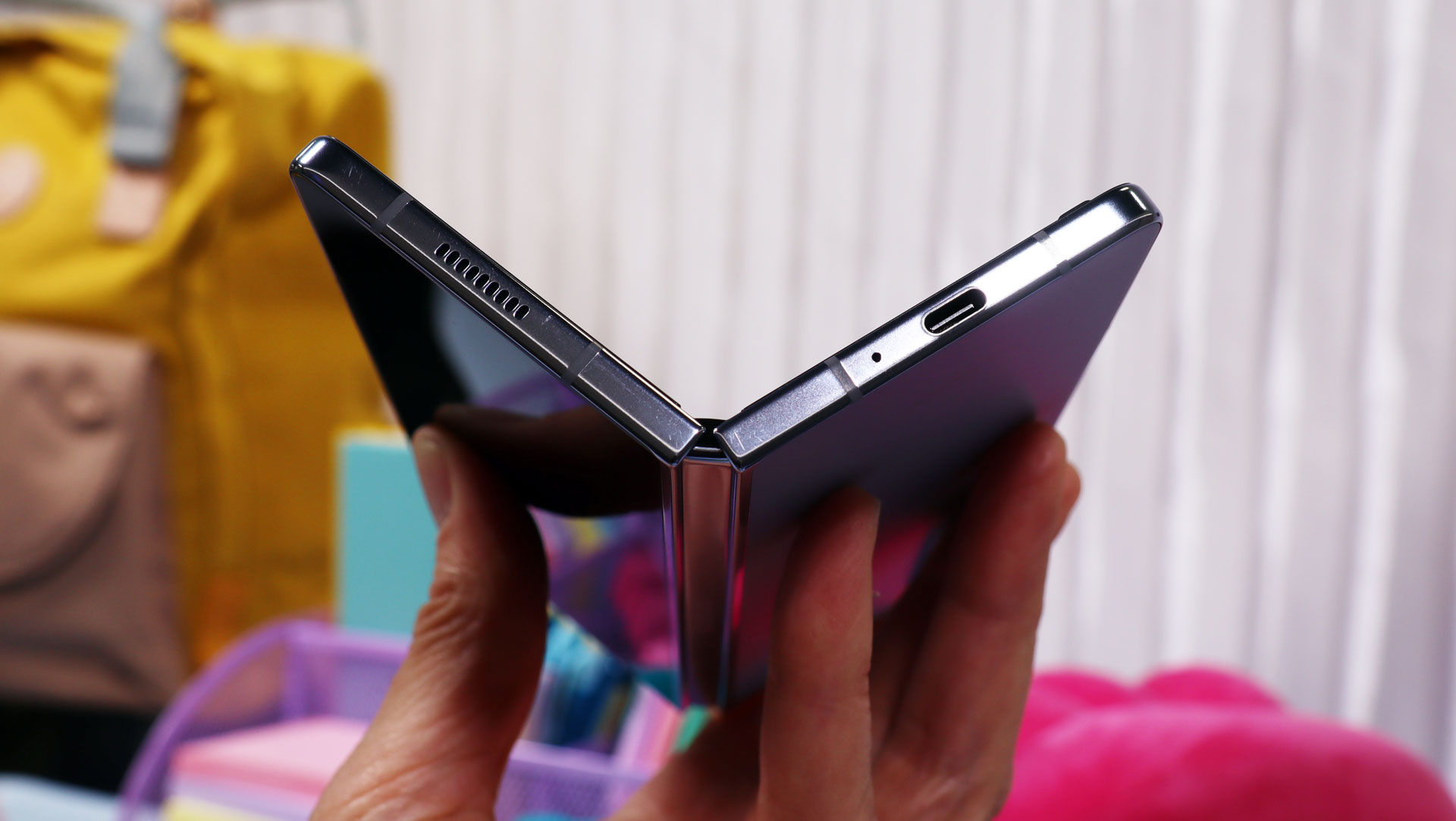
Samsung Galaxy Z Fold 5 review: Displays
- If you liked the Z Fold 4's displays, you'll like these
- No change to the resolution, refresh rate or screen size
- Removal of gap may have lessened the severity of the crease
- Wide variable refresh rate on primary screen. Cover screen slightly more limited
Once you get past the flatter fold and slightly trimmer body, you're confronted with two Dynamic AMOLED 2X displays, that haven't changed since the last Z Fold.
On the outside is the 6.2-inch AMOLED (2316 x 904) display, which features a punch-hole selfie camera. It's sharp, bright, and responsive. Like its predecessor, this cover screen offers a variable refresh rate of 48-120Hz. The listed screen size can be a bit misleading. Yes, it measures 6.2 inches diagonally, which is more than the 6.12-inch display on my iPhone 14 Pro, but this is a narrow display. Both the Pixel Fold and my iPhone 14 Pro are considerably (nearly half an inch) wider.
The benefit of the narrow cover screen is that despite this phone being twice as thick (when folded) as your average iPhone, it is still comfortable to hold. The problem, though is that it often feels cramped in use when compared to standard smartphones and, in particular, the spacious Google Pixel Fold cover screen.
It's not that I truly dislike the Z Fold 5's cover screen, but the Pixel Fold showed me what's possible and now I can't live with thumb typing on the too-narrow display. And this matters because as much as this is a dual-screen device with ample potential for productivity, I spent a lot of time on the go with it folded closed. The cover screen must be just as usable as the main screen – as it is on the Pixel Fold – and it simply isn't, not by comparison.
All that said, this is a good display for scrolling through websites, checking email, and scanning social media.
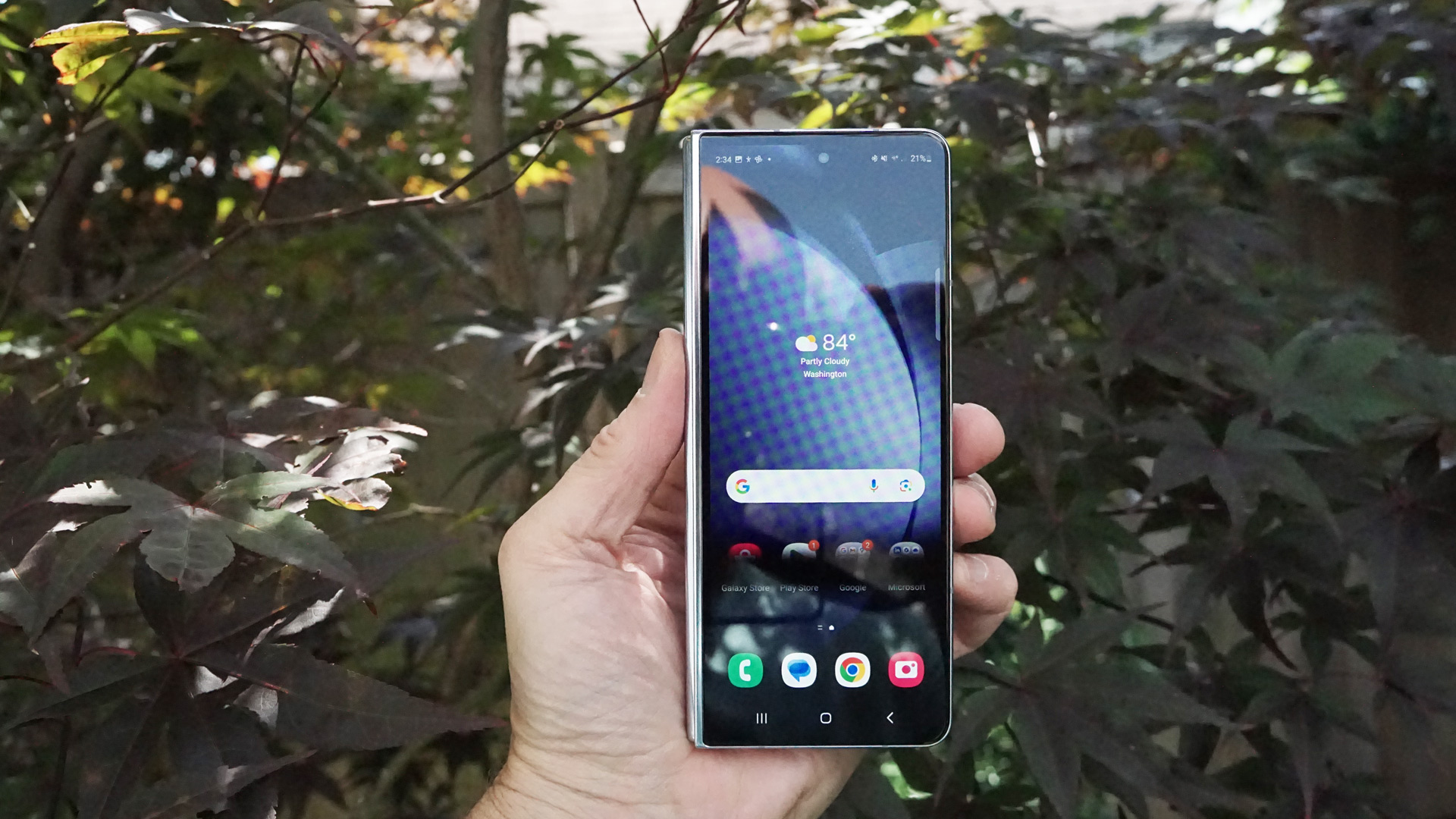
Unfold the phone and you're presented with a lovely 7.6-inch mini tablet display. It has all the right specs and resolution: a Dynamic AMOLED 2X panel with a 2176 x 1812 resolution (374ppi) and 1-120Hz adaptive refresh rate. You will notice the flexible screen crease (even if it seems slightly less pronounced), but I promise that when you're using the display to play games, watch Netflix, take photos (with it serving as your big-screen viewfinder), and manage multiple apps at once, you won't notice it.
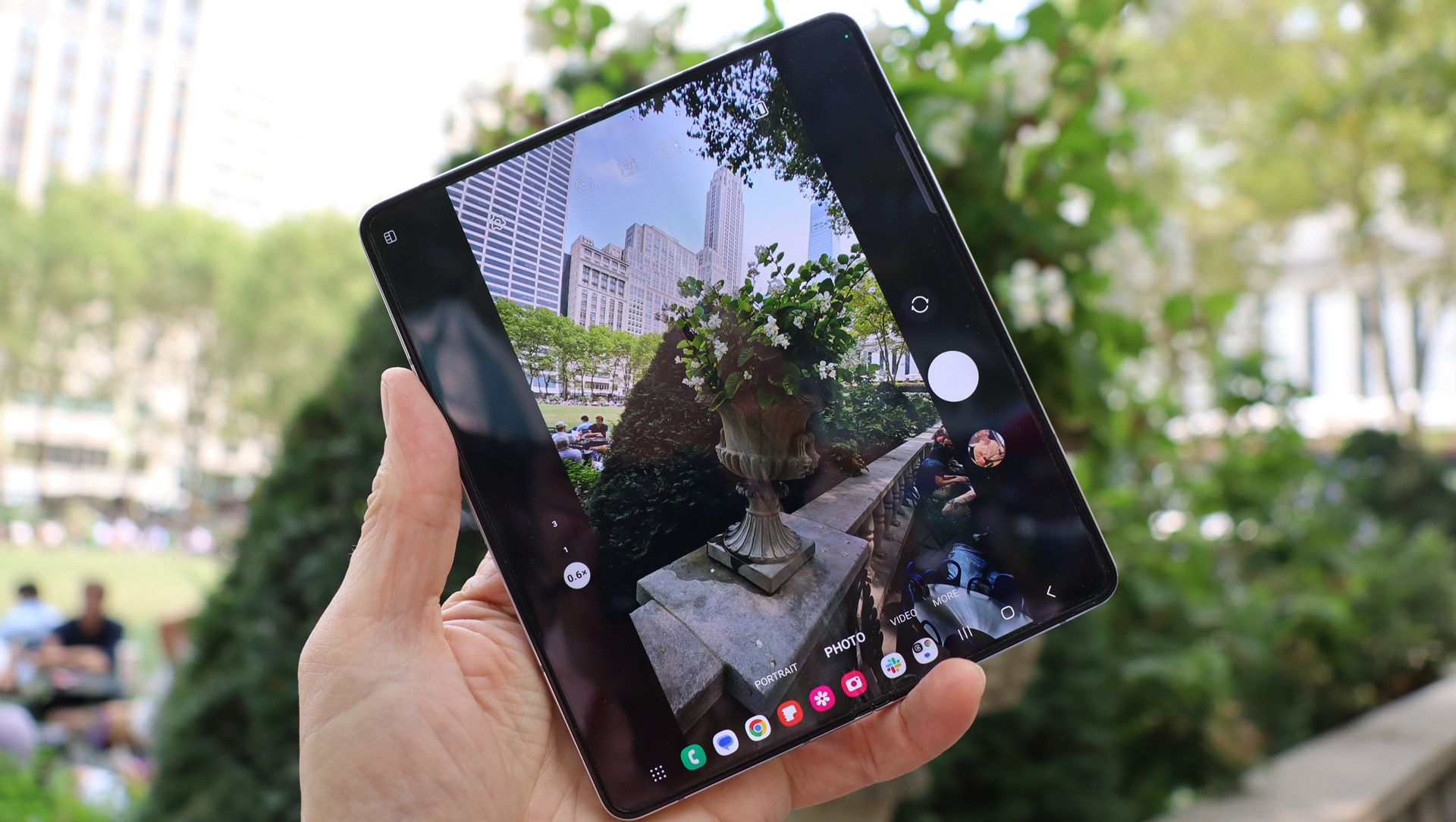
This screen is more than equal to that of the Pixel Fold, even though it has a slightly lower resolution and pixel density (the Pixel Fold sports a 2208x1840 OLED at 380ppi). I prefer the way the Z Fold 5's screen reaches from edge to edge and how, instead of using a thicker bezel for the internal front-facing camera, Samsung keeps it hidden under a small collection of pixels that it can turn off when in use. Why Samsung kept that 4MP camera instead of upgrading to a higher resolution sensor (as what you'll find on the Pixel Fold) is beyond me, but at least the 7.6-inch flexible display is top-notch.
I often used the primary screen outside and found that the display's claimed 1,750nit peak brightness (our lab tests reached 1,350nits in HDR mode) were more than capable of beating back direct sunlight.
Obviously, both of the phone's displays are touchscreens but the folding display has the added benefit of supporting pen input with Samsung's S Pen stylus. Since the phone doesn't ship with one, Samsung supplied the new $99 / £99 Galaxy Z Fold 5 Slim S Pen case, which, itself, is a pretty nifty piece of engineering. There's a little S Pen release that sits just above the stylus. To release it, I simply press the button down and the S Pen pops out of the case.
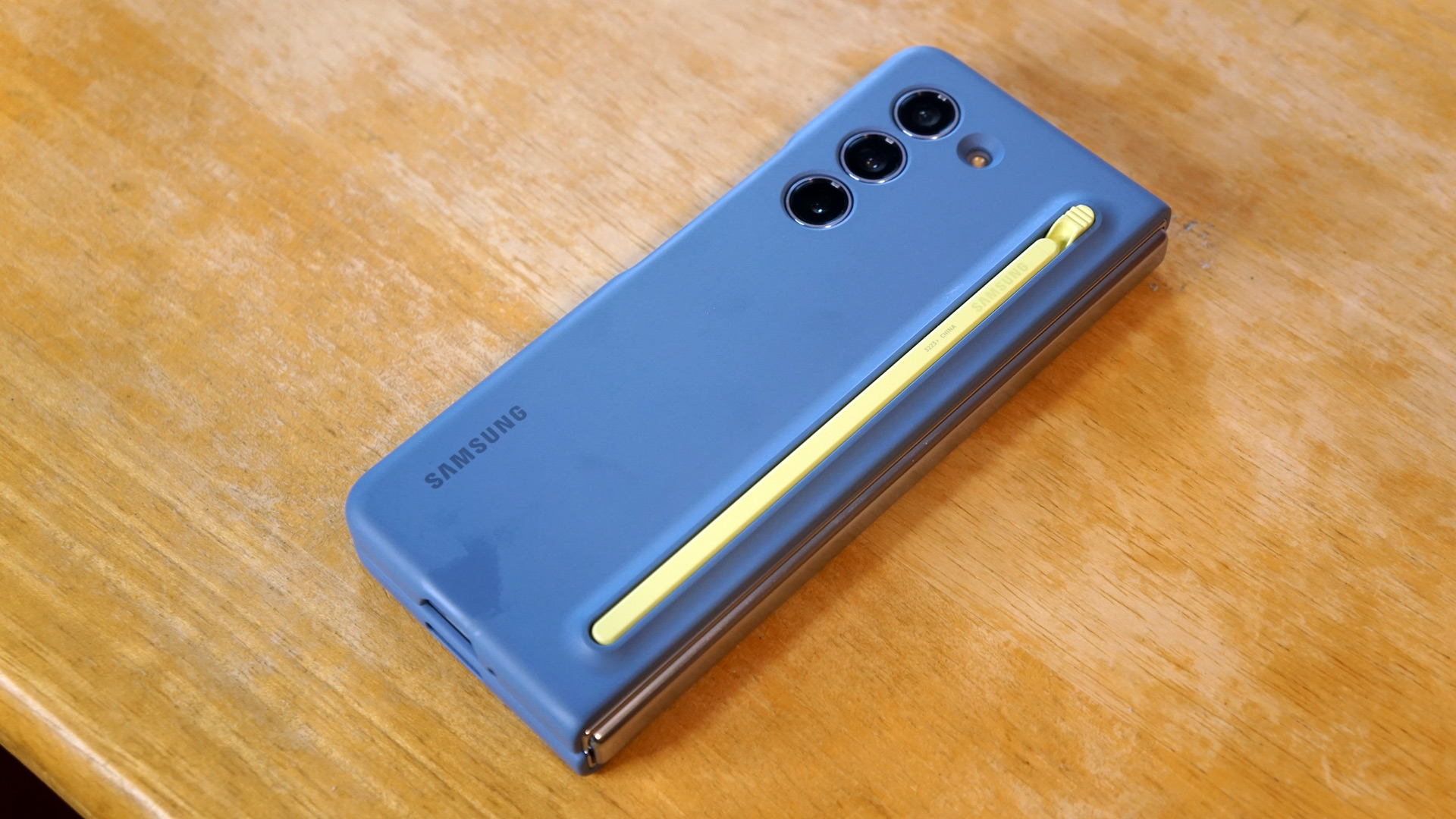
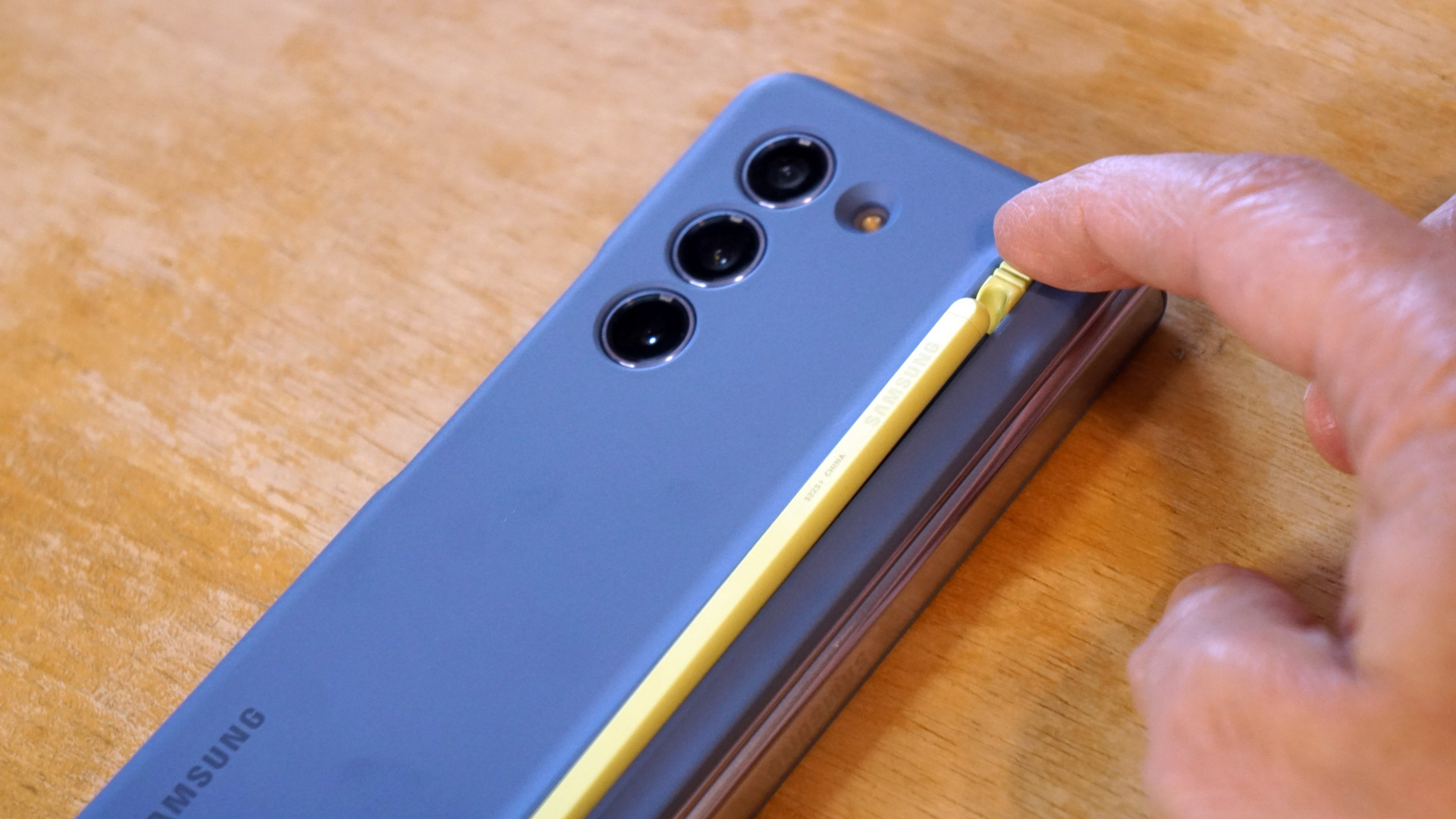
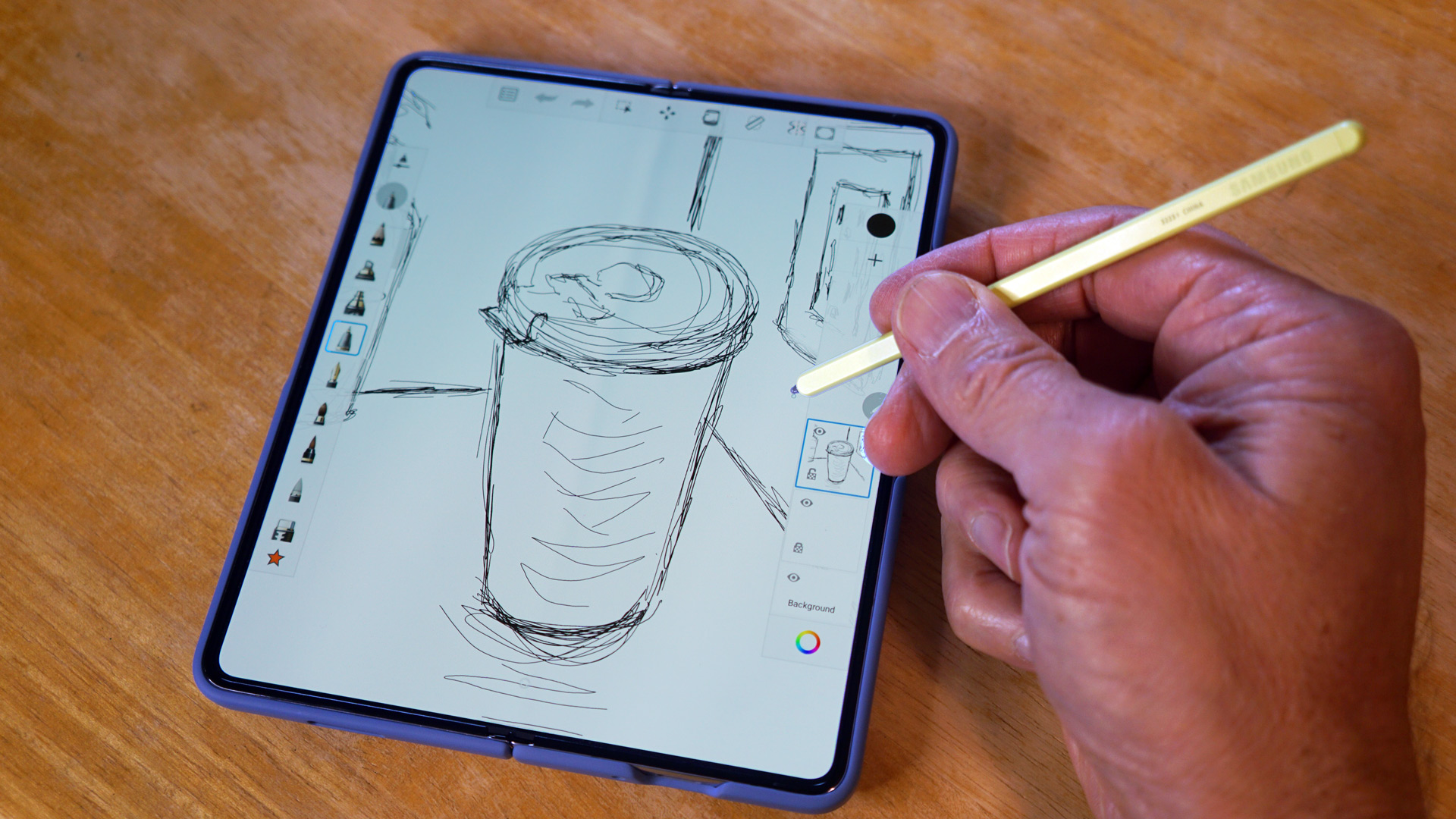
If I'm being honest, this latest S Pen is a little too thin for my tastes. That said, I did enjoy using it on the main display. It's great for quick note-taking and even drawing with apps like Sketchbook. If you're thinking about buying a case for your new Z Fold 5, I don't think there's a better choice than one that includes this pen.
Overall, everything looks good on the big primary display. It's perfect for watching videos on the train and just right for my Asphalt 9: Legends obsession. It's also versatile, thanks to its flexibility.
A tablet-sized screen means multi-tasking is on the menu. I had no trouble opening up to three apps by dragging and dropping them into position. In the center of my triad of apps is an ellipses I can tap to rotate the apps through the three positions. You might wish you could open more apps at once, but for readability and utility, I think three is enough. It's also easy to drag and drop things between these two screens. In this instance, it makes sense to have one app on one side and another on the other (say, mail on the left and images you want to drop in on the right).
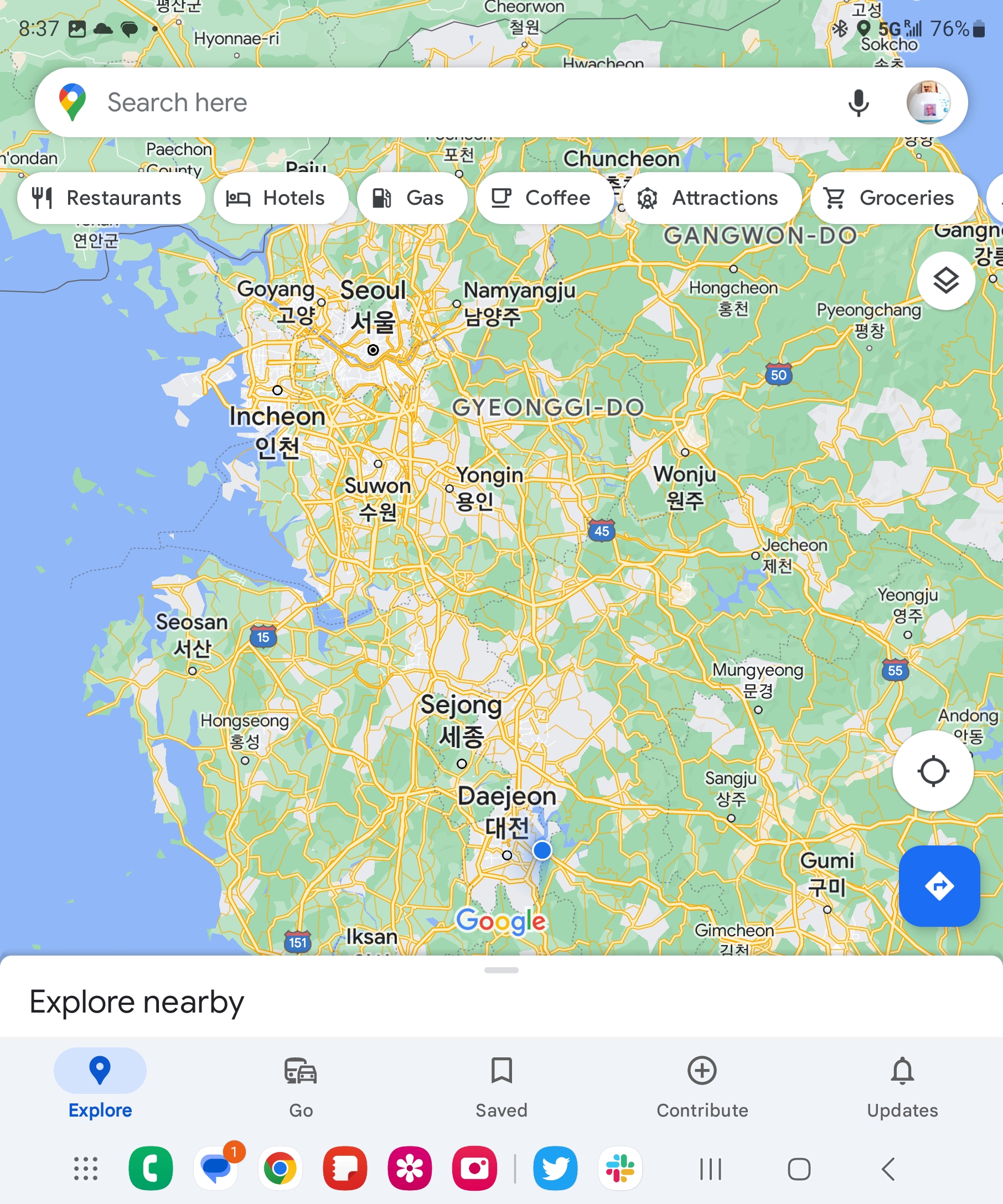
Soon after I got my review unit from Samsung, I decided to walk from a restaurant back to my hotel in Seoul with only the Galaxy Z Fold 5 to guide me. I unfolded the phone, opened Google Maps on the 7.6-inch display, and then search for my hotel. Maps found it and could locate me and my direction of travel with a little blue dot. That was helpful because Maps couldn't generate walking directions in South Korea. But all I had to do was walk and keep my eye on my blue dot on the big screen. In 15 minutes, I was back in my hotel room.
If I fold the screen 90 degrees, I can set the phone on the table and watch movies on one half of the display, scroll through my photos and videos, or use it in Flex Mode to take photos by simply waving at the screen. The Z Fold 5 also acts as its own tripod. I would place it on a chair, table, or other surface and point the rear cameras at my subject (people, the sky, the stars) and then use the on-screen controls to take the photo either immediately, or if I didn't want to risk moving the phone, on a timer. This is great for capturing hyperlapses of stars moving across the night sky and crowds of people walking by.
Unlike the Pixel Fold, there's no "Tent Mode" here that would allow you to partially unfold the handset and play content horizontally on Cover screen. Considering how narrow that display is, this probably makes sense.
- Display score: 4.5 / 5
Samsung Galaxy Z Fold 5 review: Cameras
- Same camera hardware as the Z Fold 4
- Rear cameras capture lovely (if slightly over-saturated) imagery
- Samsung should've upgraded the 4MP under-display camera
While it's unusual for a phone manufacturer like Samsung to leave an entire collection of cameras untouched from one model to the next, I understand the strategy with the Z Fold 5. Not many people have foldable phones or bought the Z Fold 4. Look around, do you see many people on the train or in the park with them? Exactly.
Samsung rightly believes the Galaxy Z Fold 5 (or its sexier counterpart the Galaxy Z Flip 5) may be consumers' first encounter with foldable phones. The camera collection (with one exception) on the Z Fold 4 was quite good. It's unlikely you will be dissatisfied with what Samsung has on offer here.
Here’s the full list of cameras:
- Cover display camera: 10MP selfie camera f/2.2, pixel size: 1.22μm, FOV: 85 degrees
- Folding display camera: 4MP under-display f/1.8, pixel size: 2.0μm, FOV: 80 degrees
- Rear camera: 12MP ultra-wide f/2.2, pixel size: 1.12μm, FOV: 123 degrees
- Rear camera: 50MP wide-angle with dual-pixel AF and OIS, f/1.8, pixel size: 1.0μm, FOV: 85 degrees
- Rear camera: 10MP telephoto f/2.4, OIS, pixel size: 1.0μm, FOV: 36 degrees, 3x optical zoom
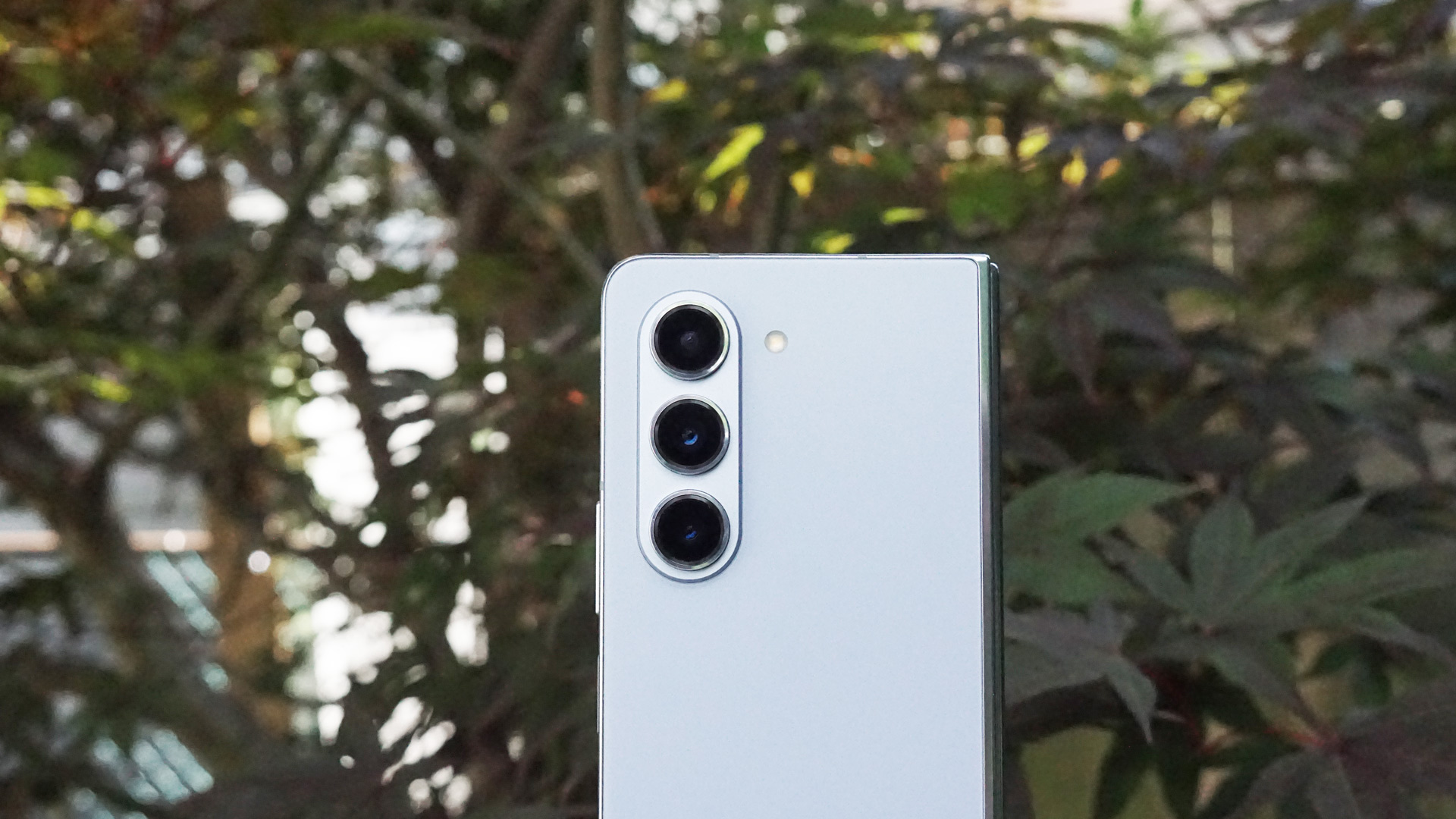
Naturally, there is a risk here, in that foldable phone choices are growing by the minute. Since I last reviewed the Z Fold 4, Google released the Pixel Fold and it does, in some ways, beat the Z Fold 5's camera capabilities, and don't even get me started on the wealth of foldable options available to consumers in the UK and Europe (entries from Oppo, Honor and Huawei all spring to mind).
In particular, Google beats Samsung on optical zoom, offering 5x over Samsung's 3x magnification. Samsung will tout its impressive 30x space zoom capabilities, but photos taken with that digitally-enhanced feature don't hold up that well under close scrutiny. Plus, some of the imagery is a combination of real imagery and what AI understands of your subject. That, for me, is not real photography.
Even so, I really enjoyed using the Z Fold 5's cameras. The photos and portrait mode shots are, in some cases, breathtaking. Samsung's habit of punching up the colors works mostly in its favor. I do love a more brilliantly blue sky and even more purple flowers. Verisimilitude is, perhaps, not Samsung's strong suit but I bet everyone will love your Galaxy Z Fold 5 snaps.
Even though Samsung didn't change the sensors, they're all backed by a much more powerful chispet; the Qualcomm Snapdragon 8 Gen 2 brings better image processing, which I saw on display in the excellent low-light night photography. Whether it was in a restaurant capturing a 20-course Korean dinner, or the beautiful Seoul skyline, the photos look quite good.
The camera is also fast, even with portrait mode shots. I took some photos of people learning to juggle and was stunned at not only how well the main 50MP camera caught the jugglers in action, but the way it also identified the balls in flight and put them in focus along with my subject.
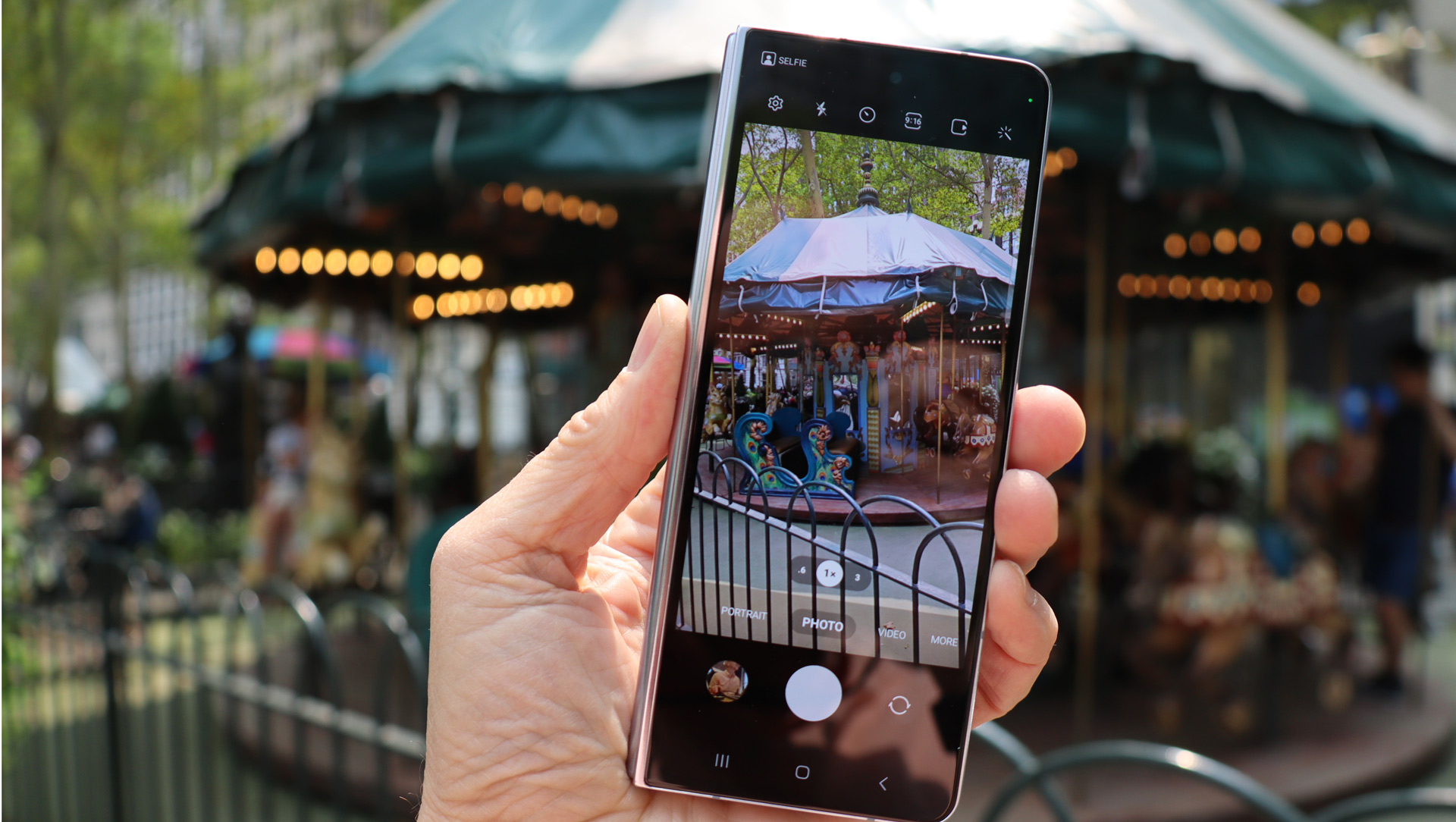
My point is, if you have a good lens and sensor, sometimes all you need is to update the silicon for better speed and image processing.
Most of my Samsung Galaxy Z Fold 5 photography was taken while the phone was closed, using one of the three lenses on the back and the cover screen as my viewfinder. I could open the phone up and use the main screen, but it's a bit unwieldy. For a selfie, I could use the 10MP cover display camera (recommended), the 4MP folding display camera (not recommended but it's fine for video conferencing), or the best cameras on the phone.
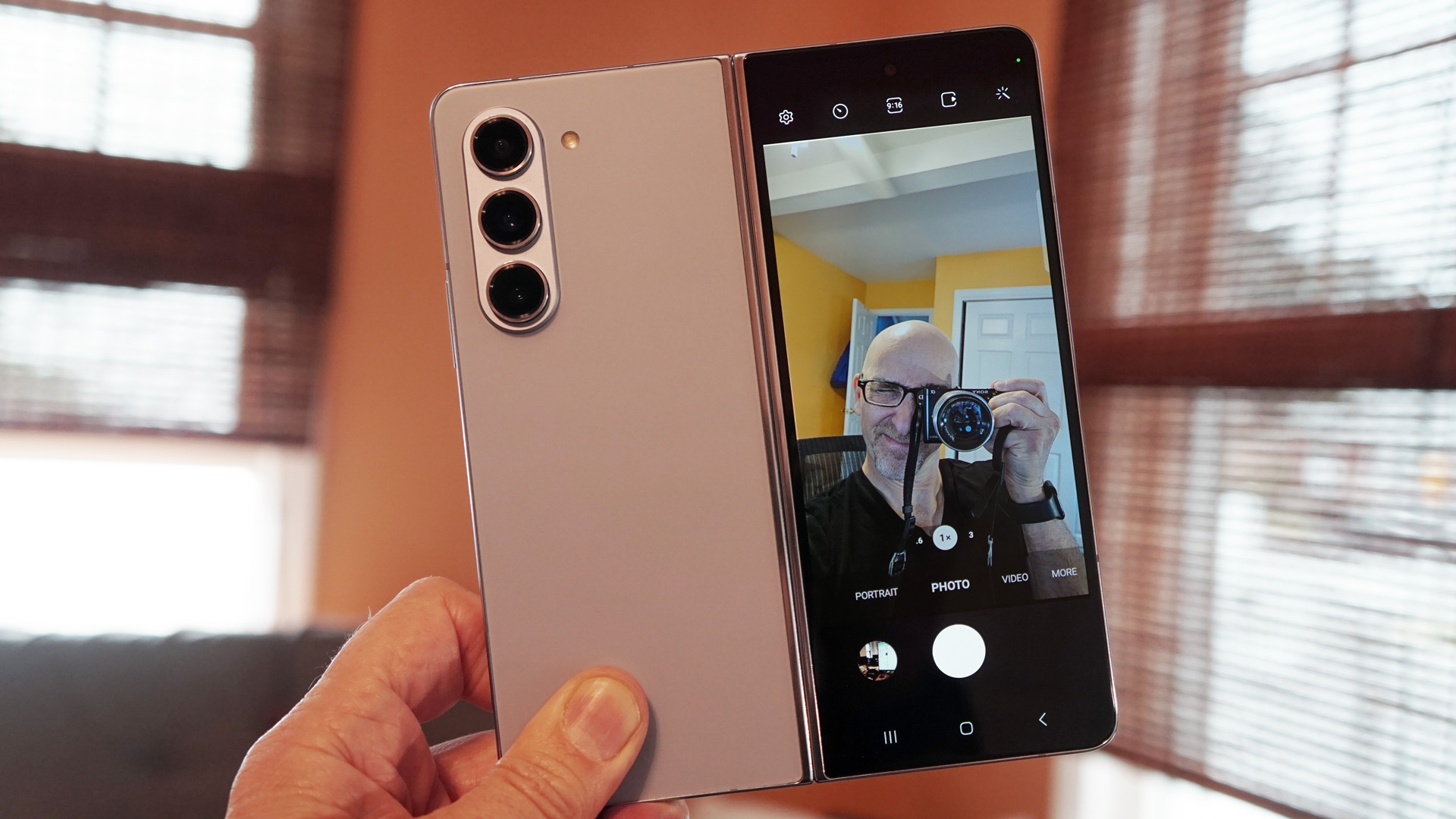
To do so, I unfolded the phone and selected the "Cover Preview Screen" icon in the upper right-hand corner of the camera app. This let me use the cover screen as my viewfinder, while the rear camera array was facing me. I could even have full control over all photography features by sliding the lock symbol on the cover screen to the left or right.
The reason for this is that it allows you to shoot with the phone's best camera array whether you're taking standard shots or selfies. It's a nice feature but I generally didn't like shooting with the phone unfolded because I worried I might drop it.
I also shot some video, right up to 8K 30fps, and was pleased to find that there was zero stutter during shooting or playback, though I do think the 60fps 4K video is a bit more buttery smooth on playback. Either way, you can shoot some high-quality videos with this phone. For the auteurs among us, you can shoot using Pro video mode, which gives you custom control over everything from focus point to speed and microphone (omni vs just the front or rear mics, or even an external one).
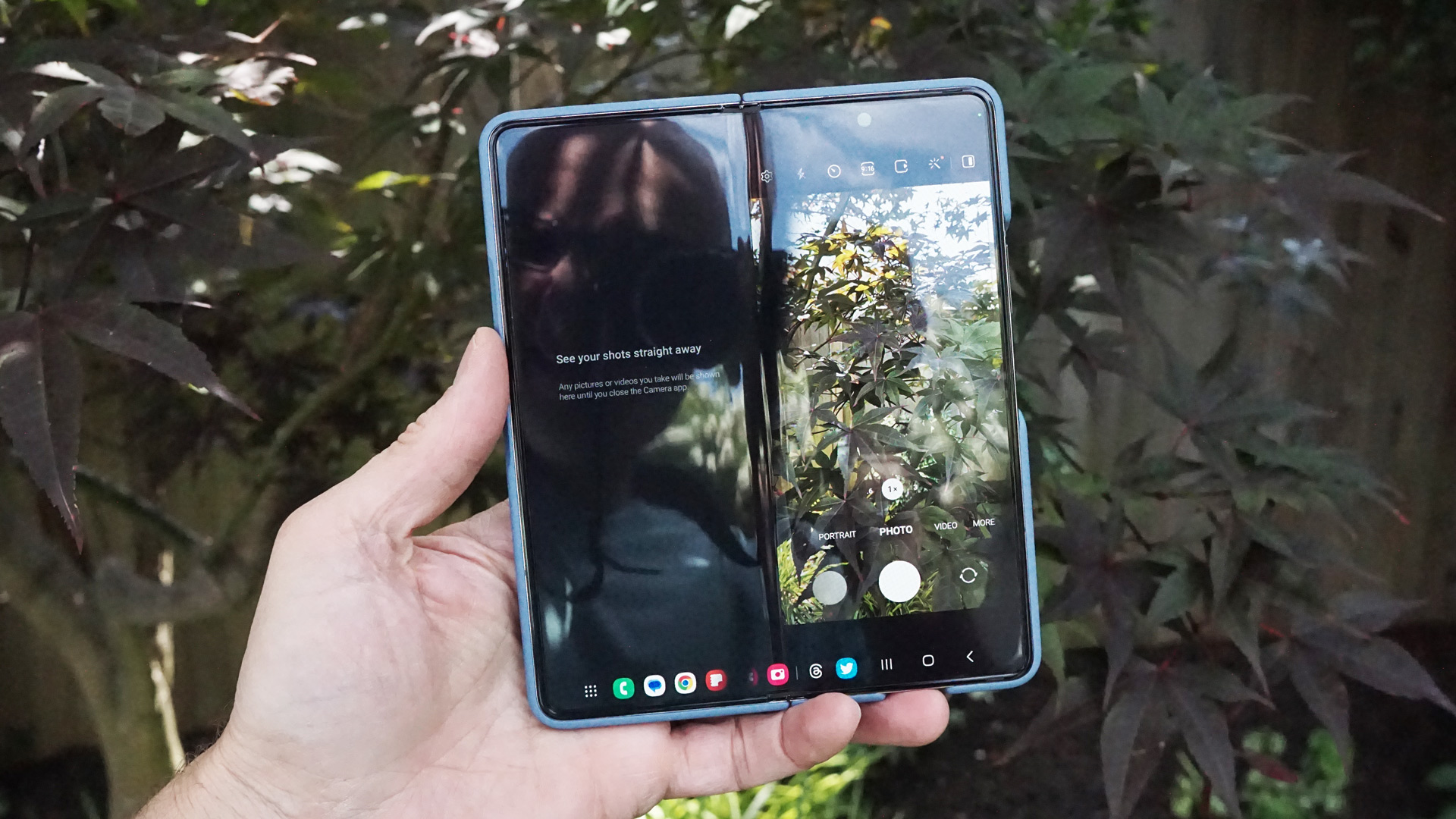
In general, Samsung's Camera app is richer than Apple's, though Samsung tends to hide a lot under the "More" menu. For manual control, you can switch to "Pro" (under More). There's also the free Samsung Expert Raw app, which lets you switch between shooting 12MP stills (combining four pixels at a time) and 50MP raw images. It also lets you control all your camera's manual settings. I still don't understand why Expert Raw isn't pre-loaded on these phones, but at least it's accessible.
Samsung generally gives you more control over camera features than Apple. Hyperlapse – an analog to Apple's Timelapse – offers six different settings and explains how you might use each one (300x is good for tracking the stars, for example).

- Camera score: 4 / 5
Samsung Galaxy Z Fold 5 review: Camera samples
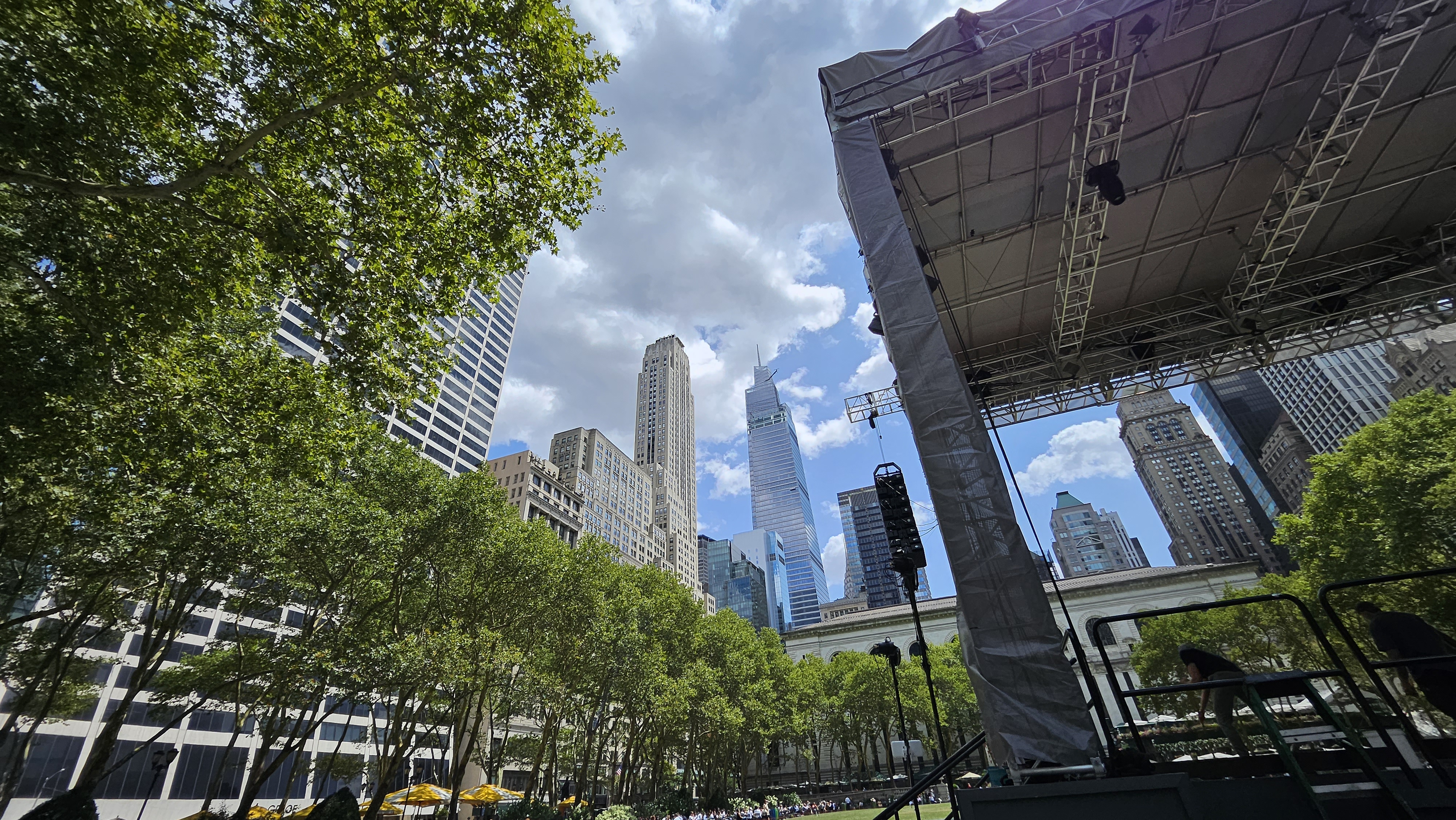
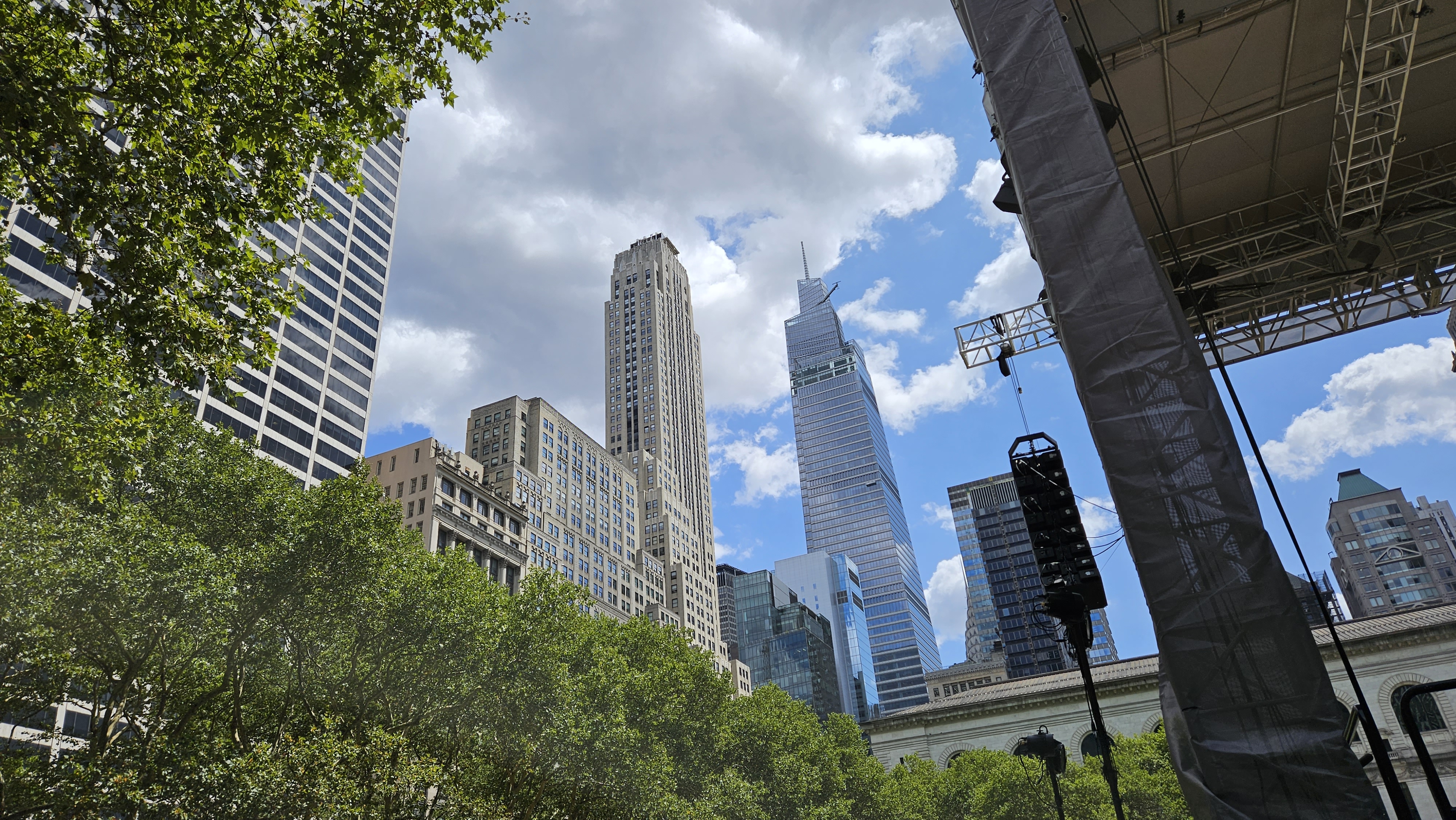

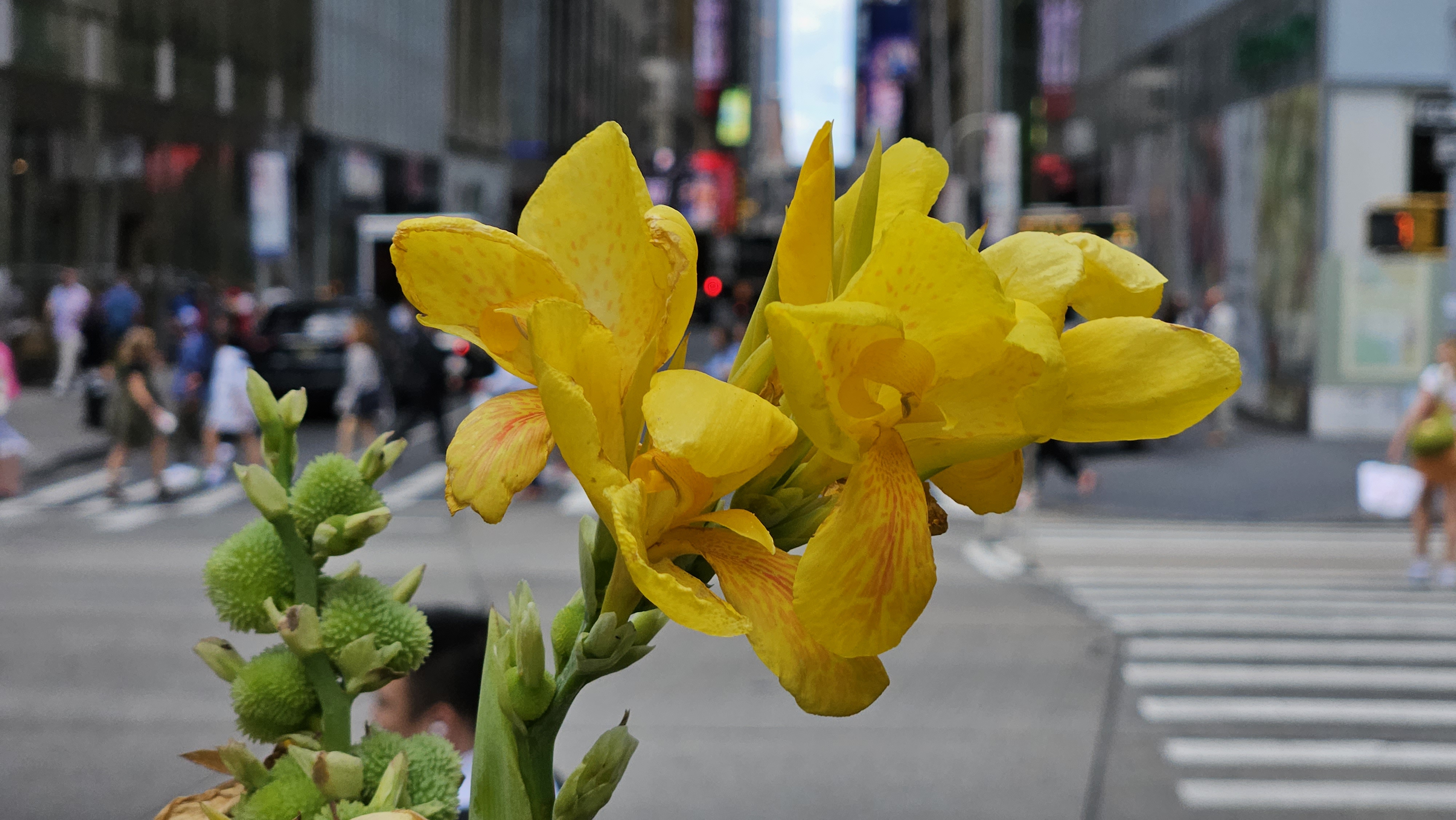
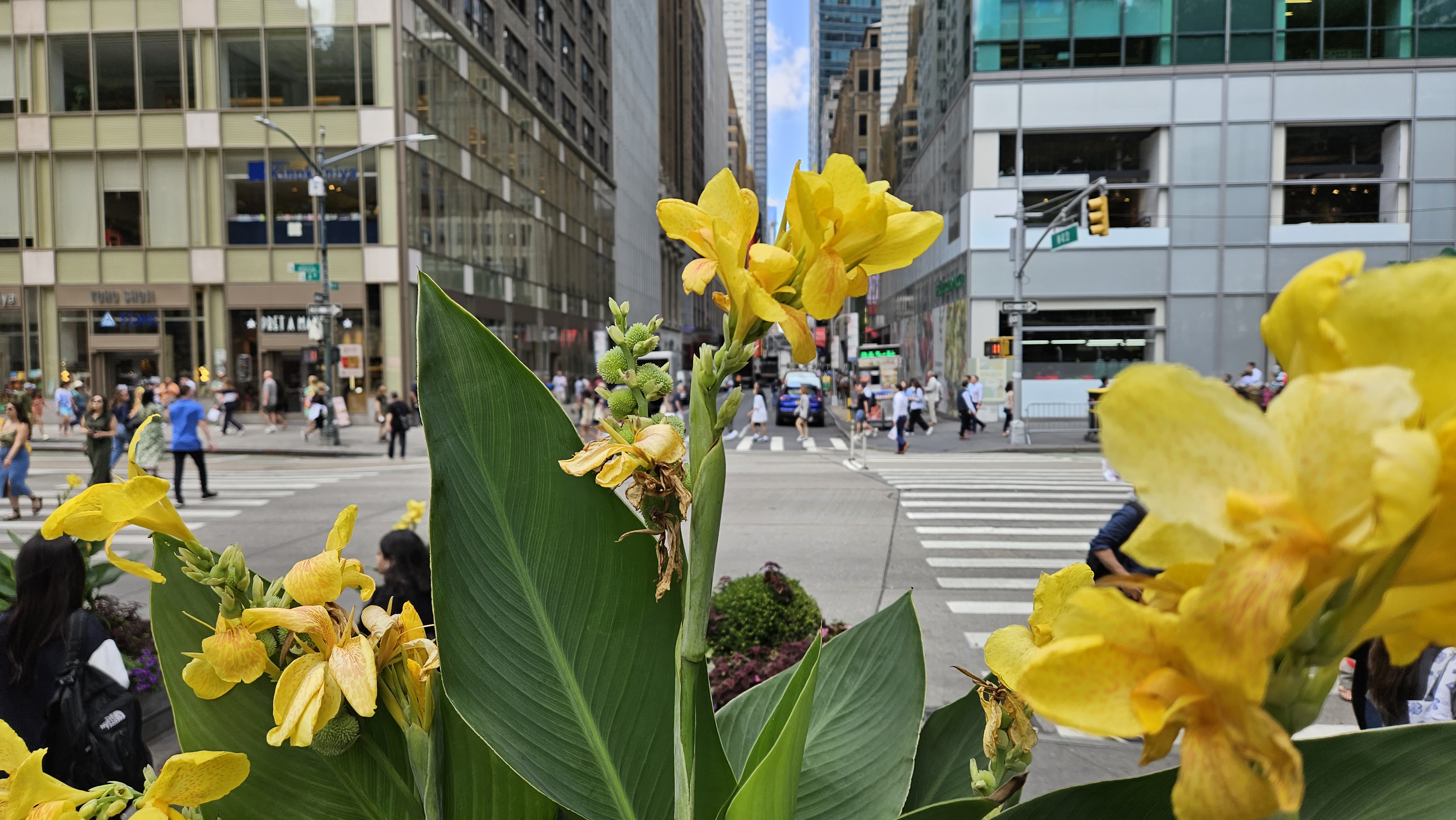
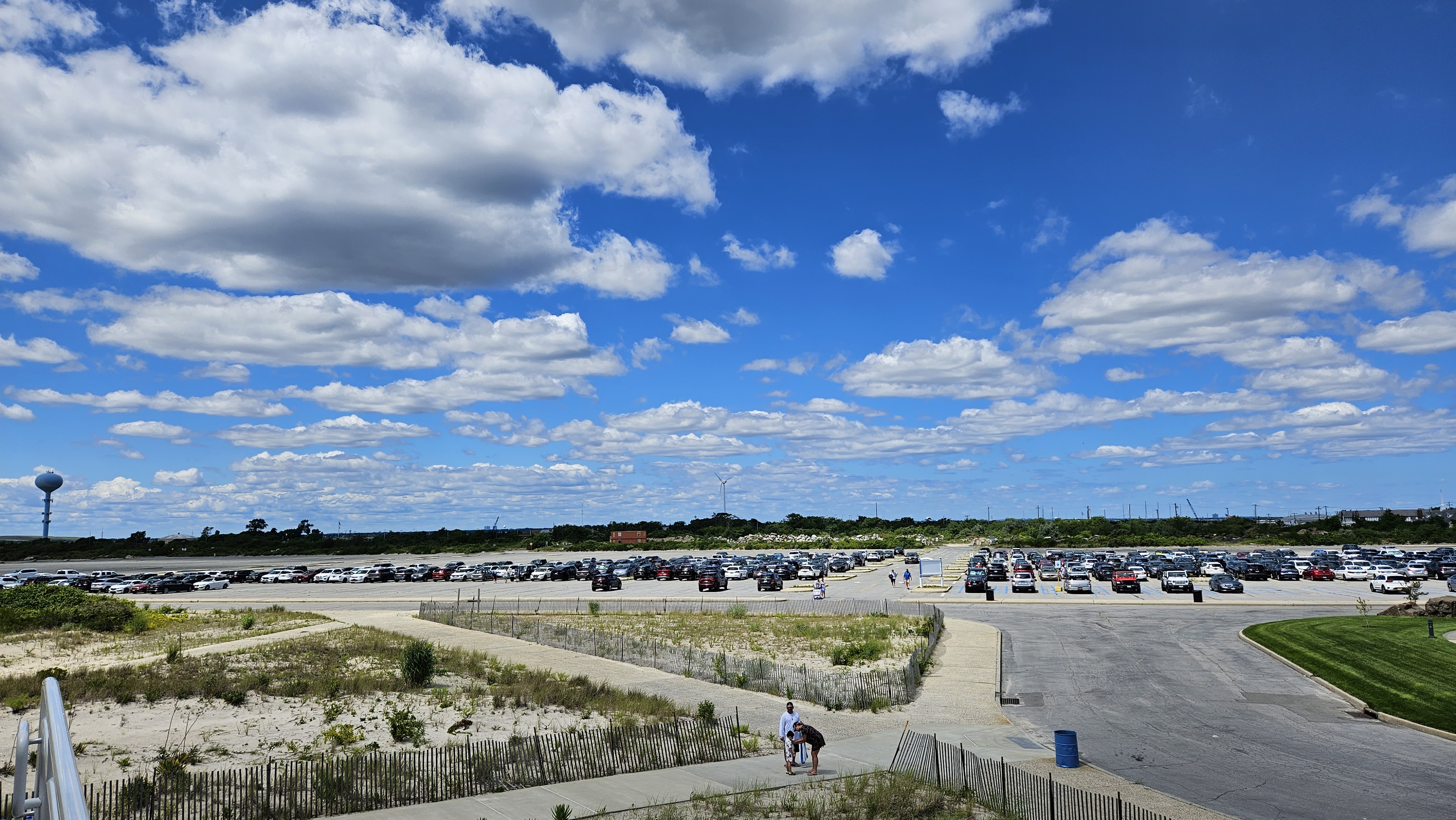
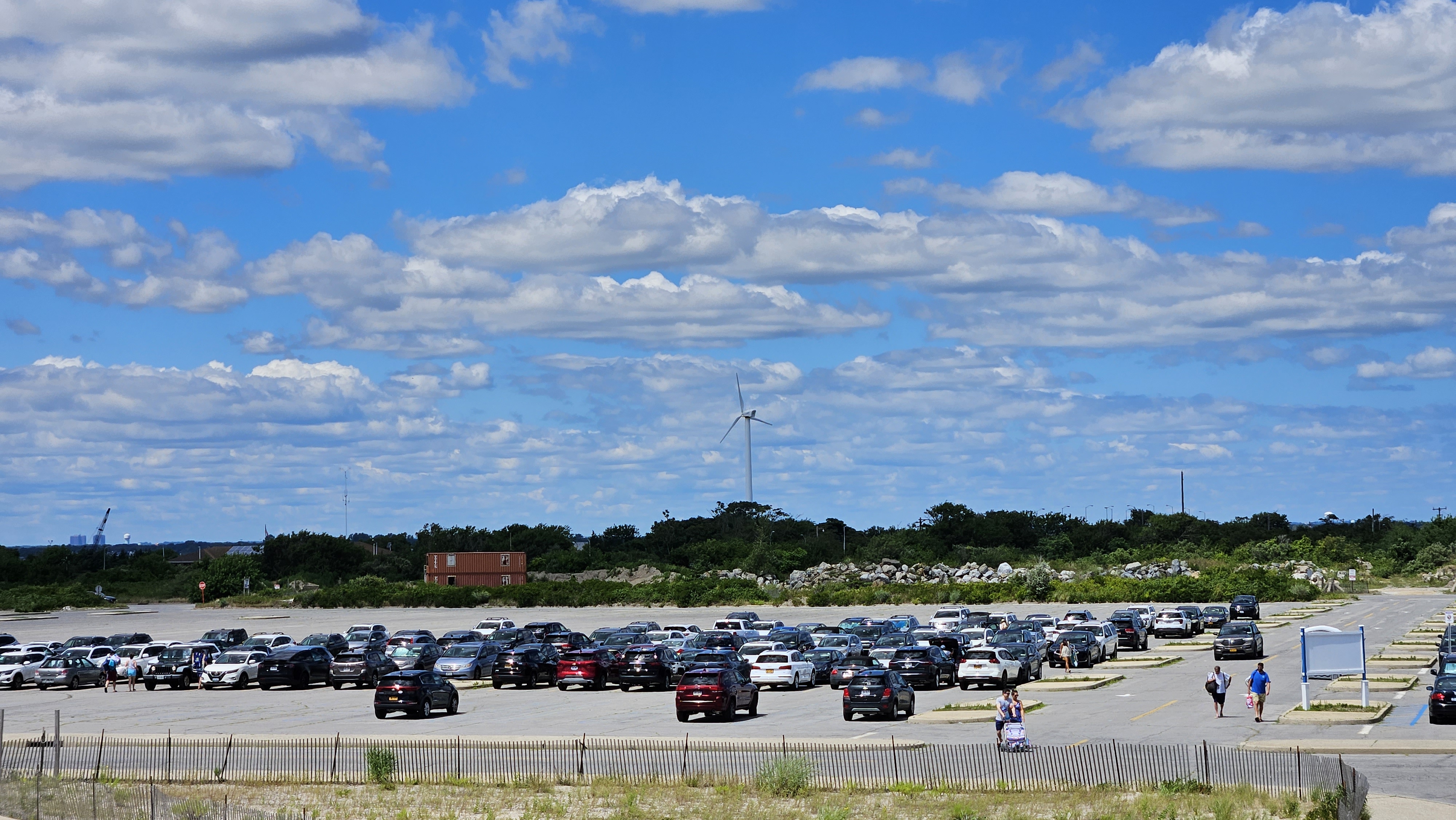

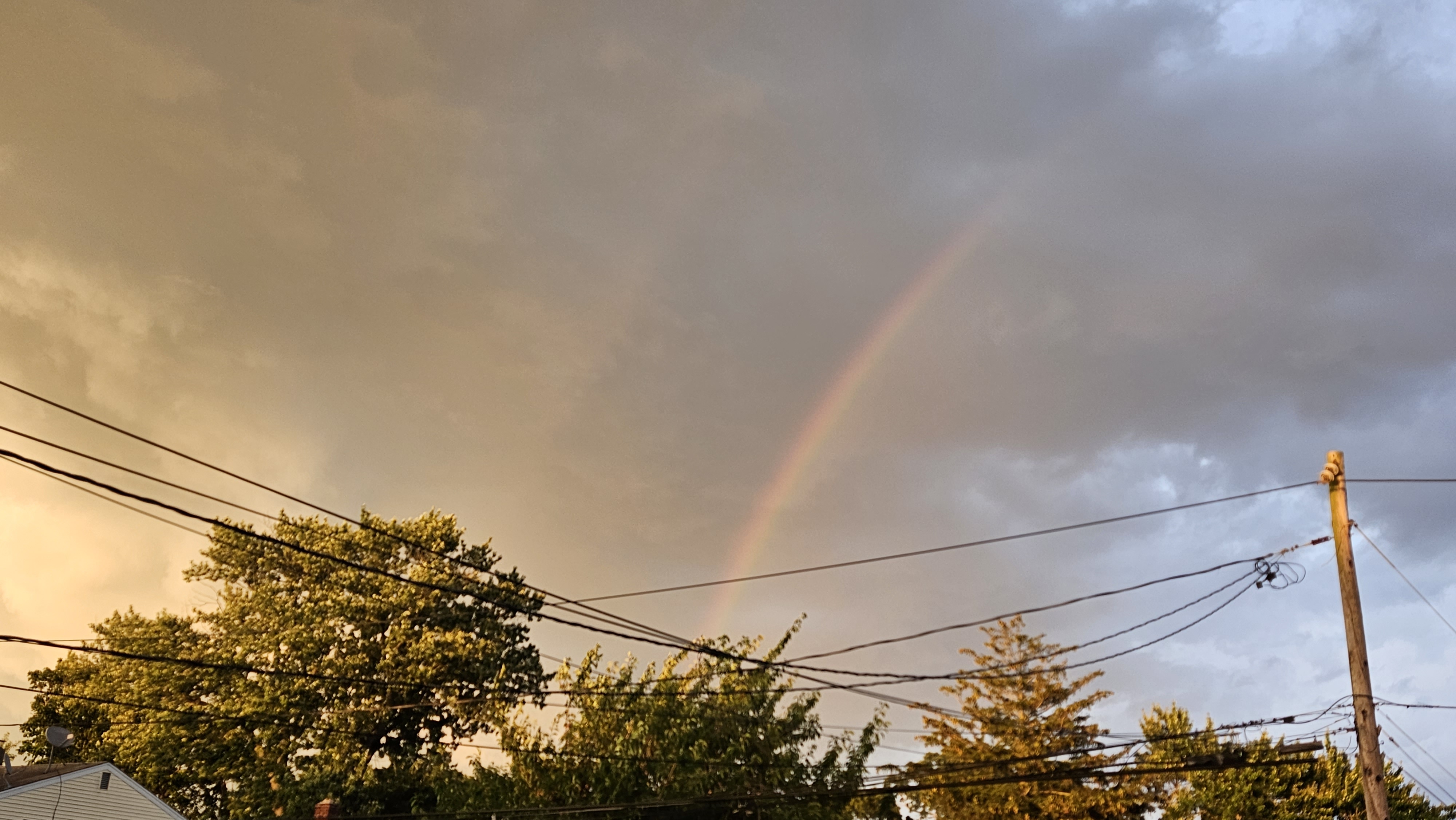
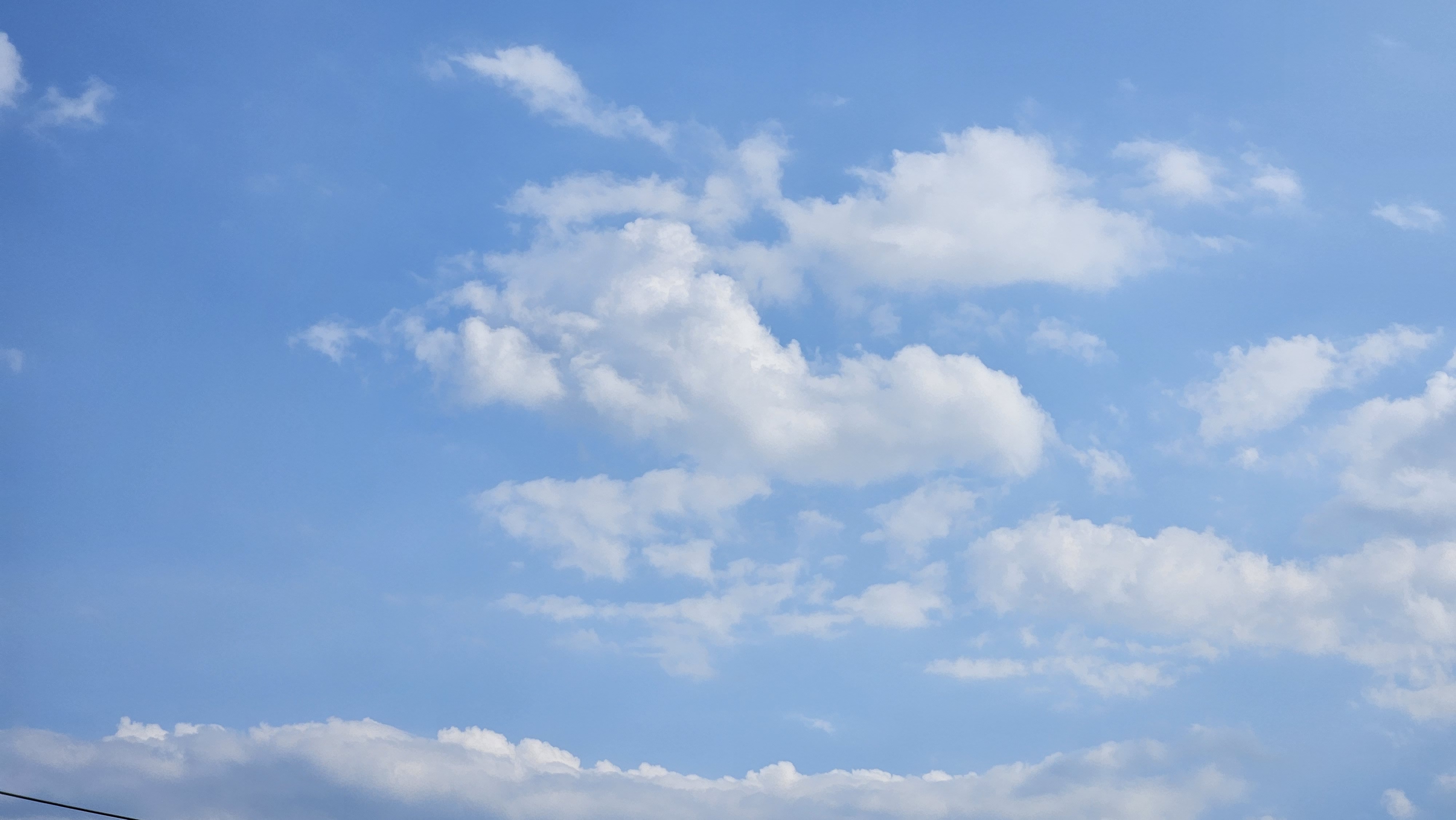
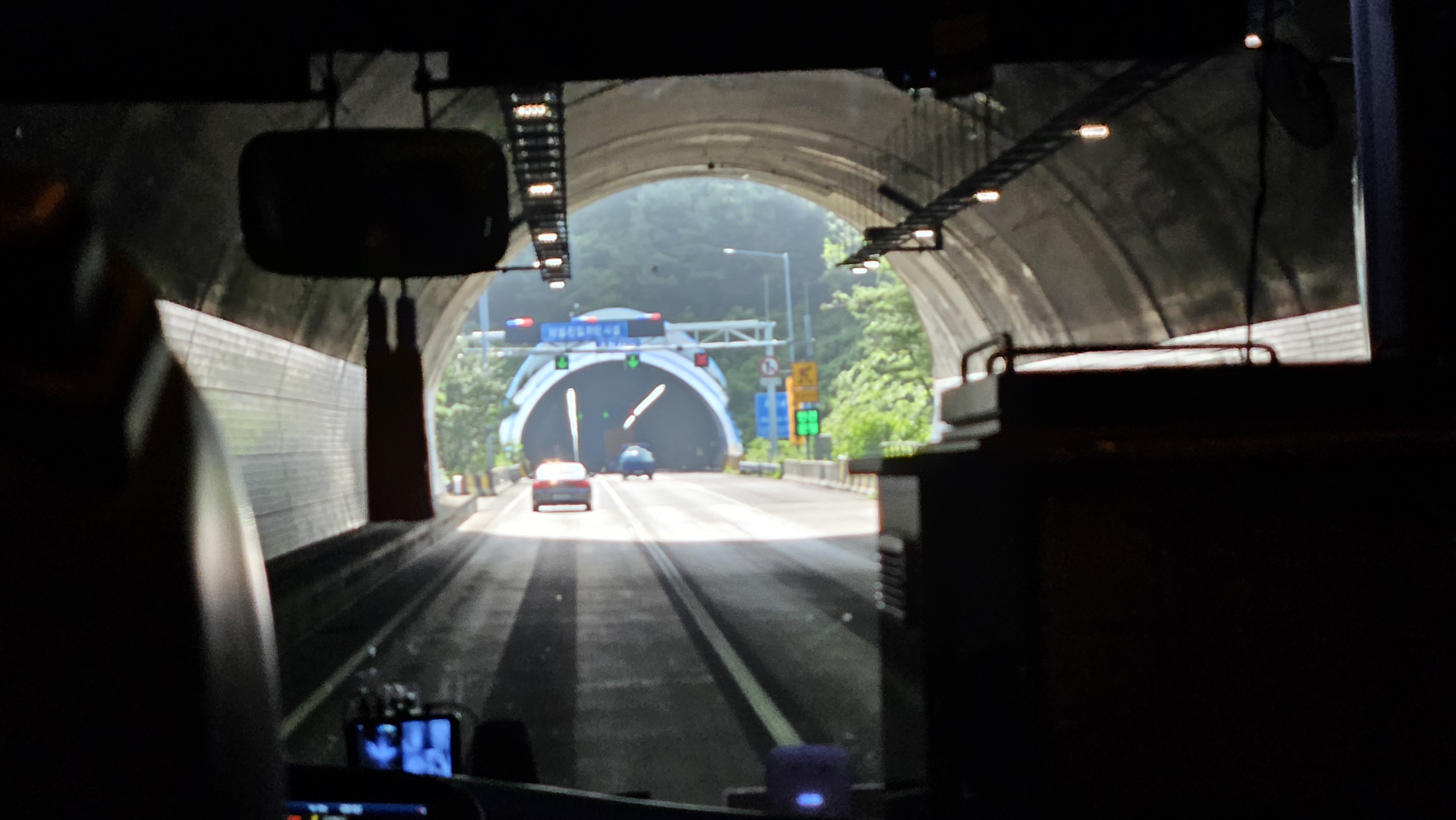
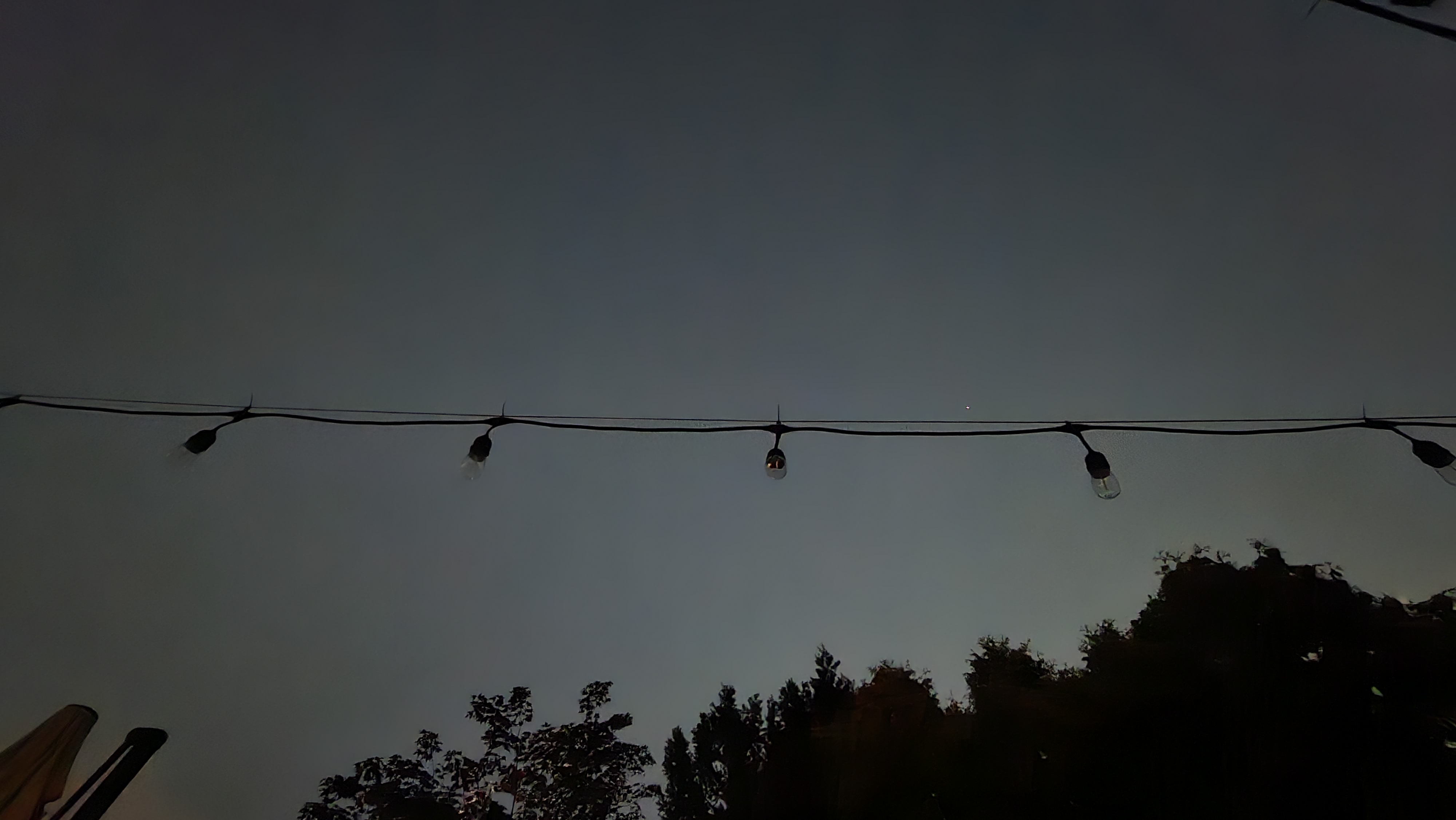
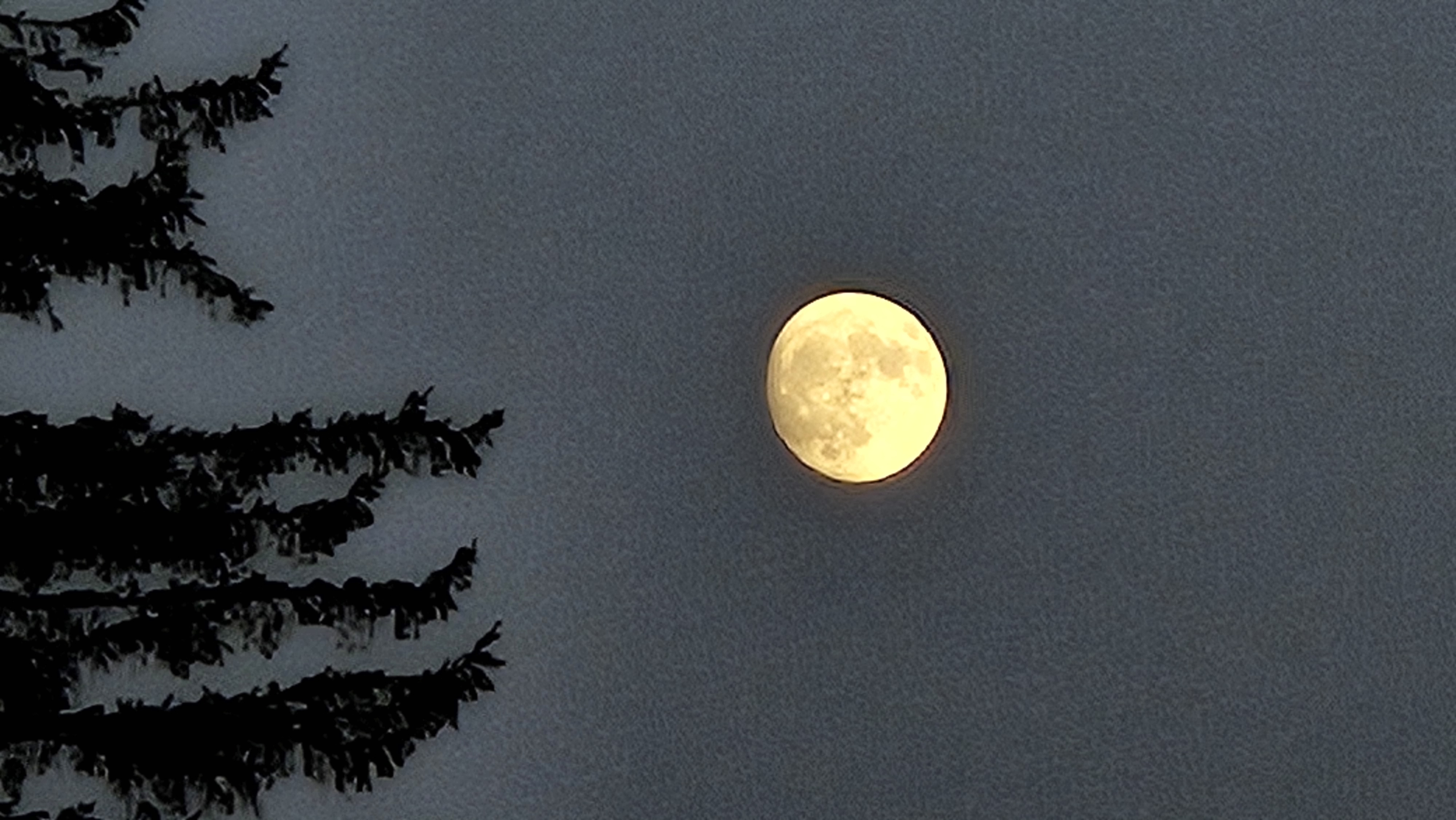
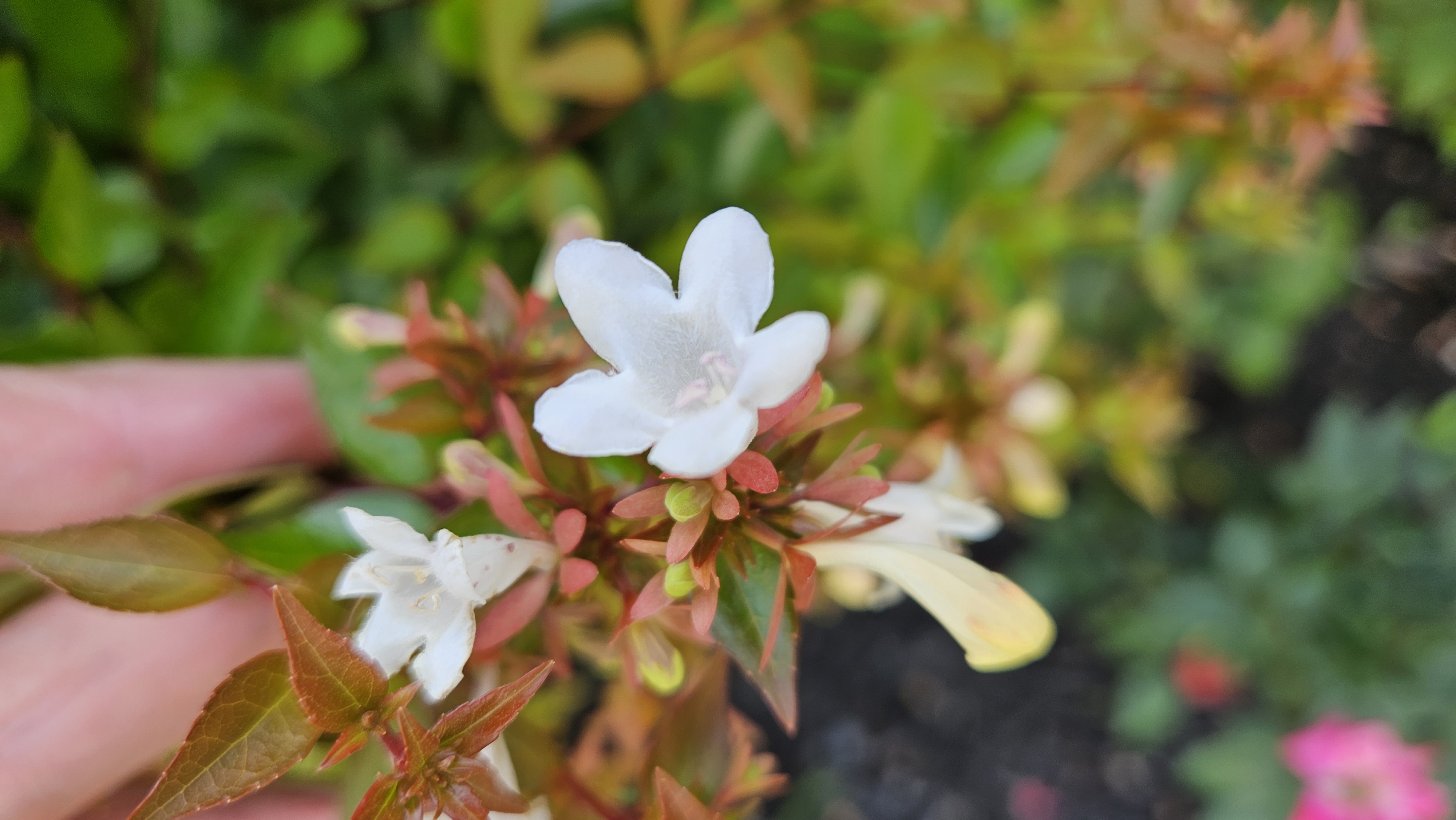

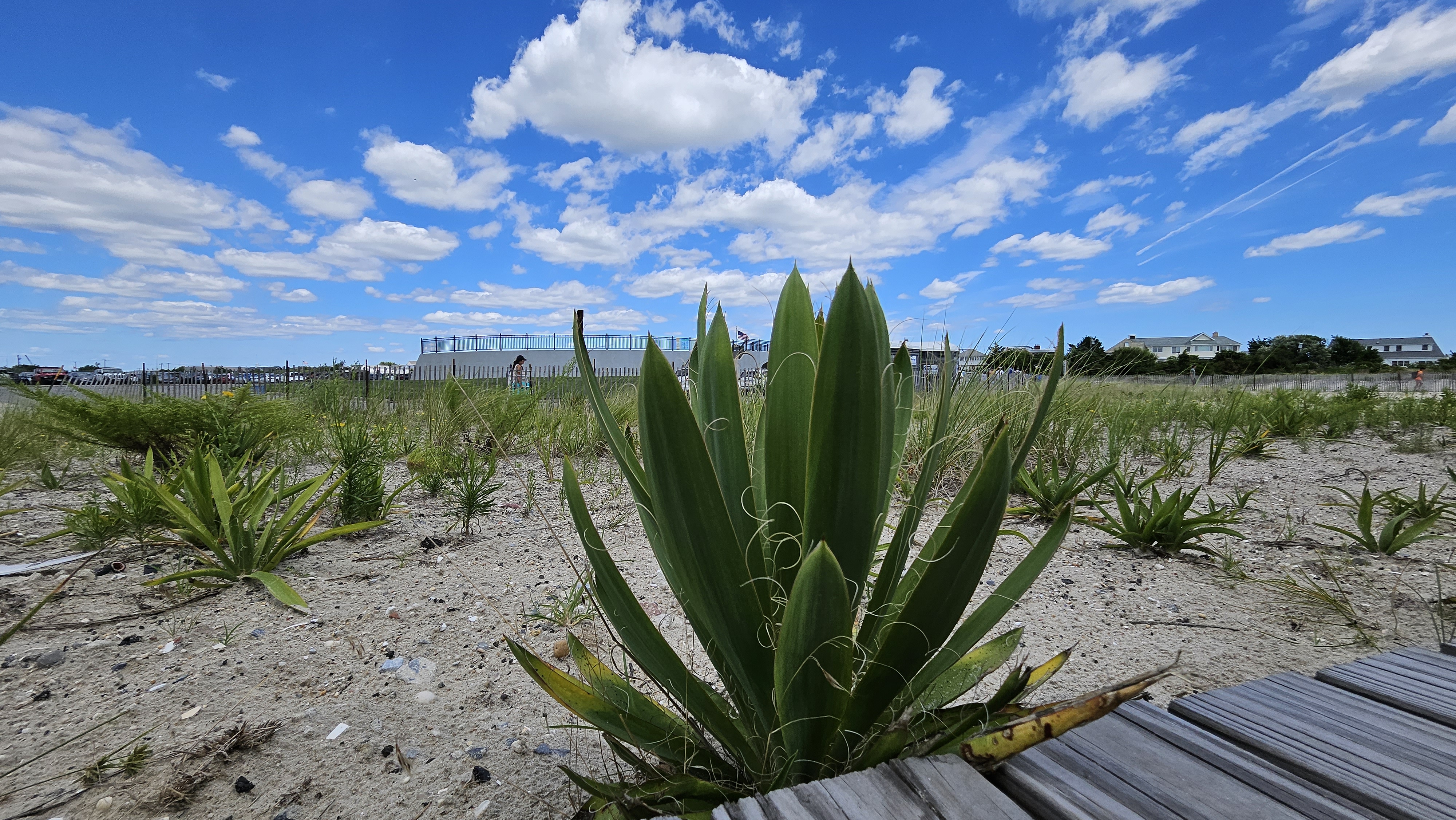
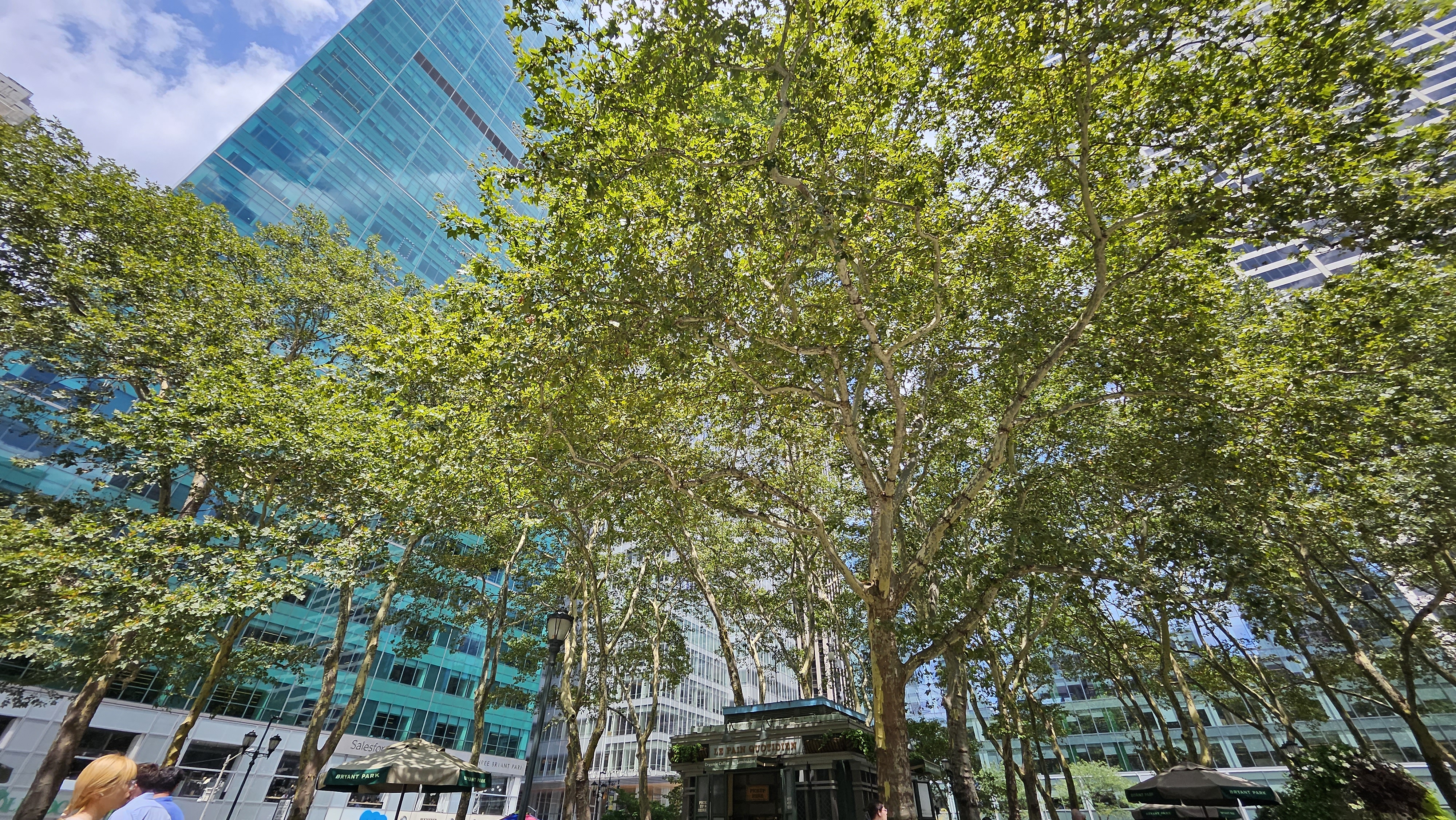
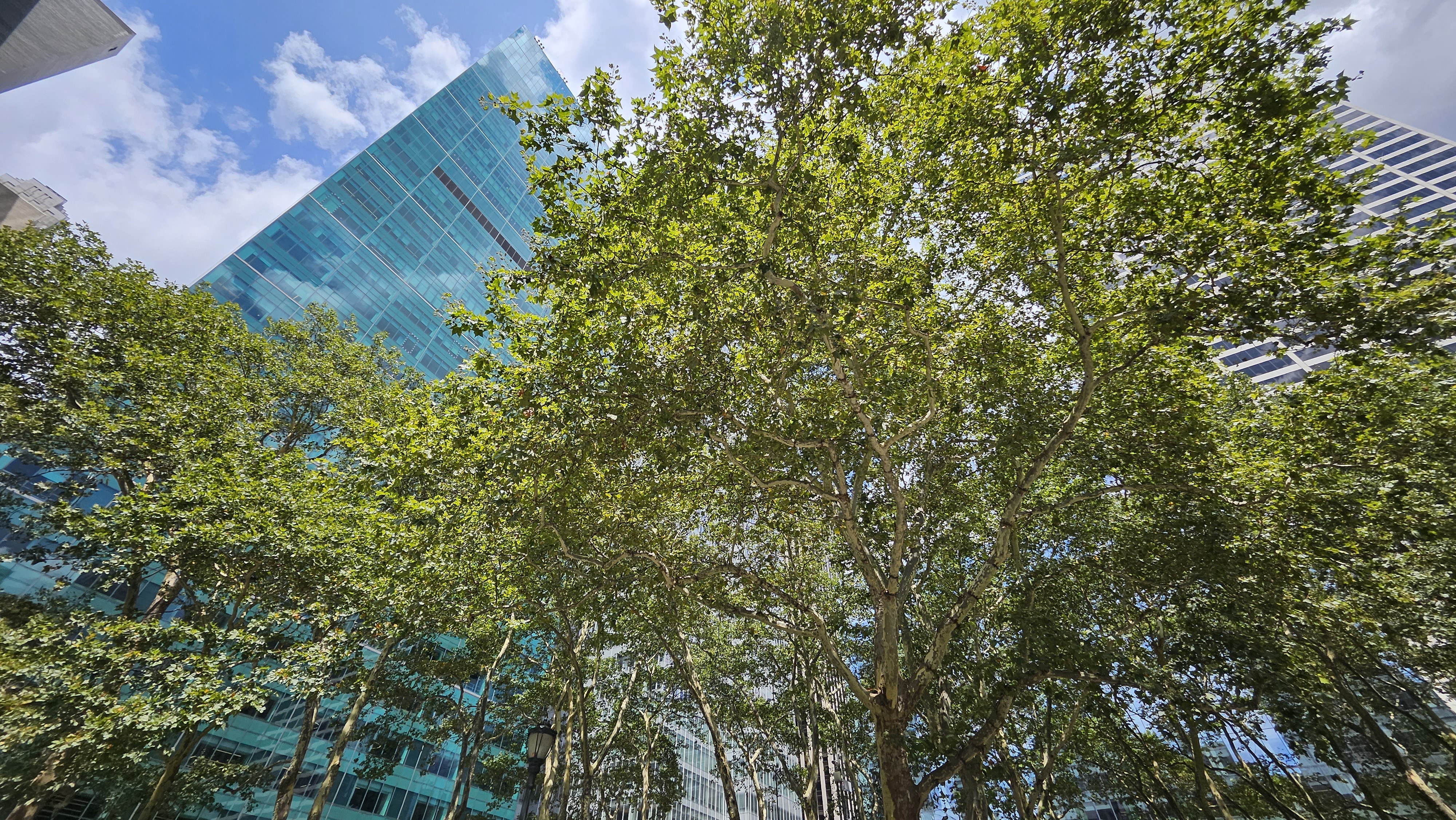
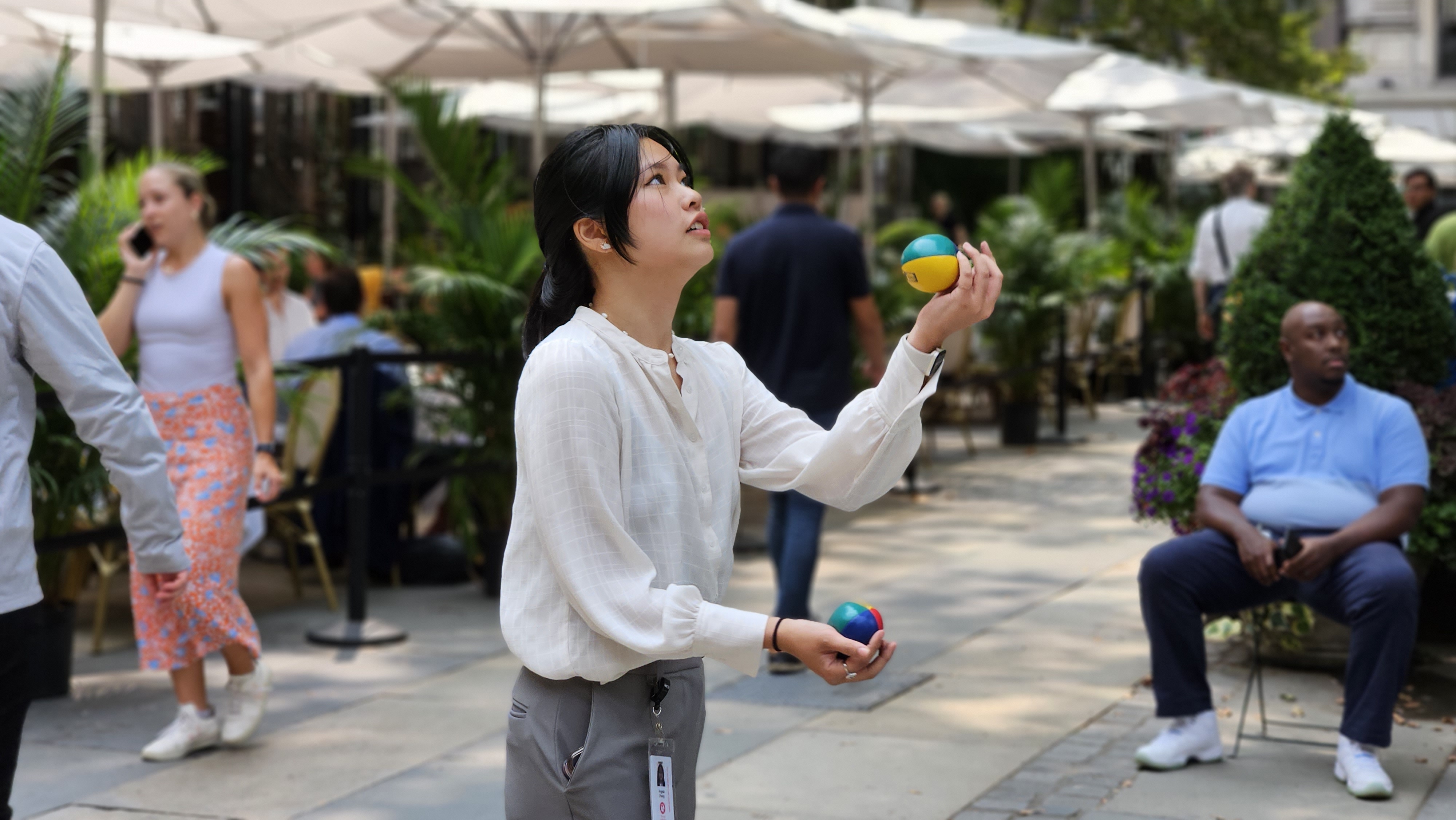
Samsung Galaxy Z Fold 5 review: Performance and specs
- Samsung pulls its foldables into alignment with the S23 line
- The Snapdragon 8 Gen 2 'for Galaxy' is peppy
- 12GB of RAM and starts at 256GB of storage
Samsung may not have done much to the cameras or other Galaxy Z Fold 5 components, but it swapped out what matters. There's the still-fresh Qualcomm Snapdragon 8 Gen 2 'for Galaxy' SoC, the slightly over-clocked version of the chip now also found on the entire Galaxy S23 line. That's backed by 12GB of (LPDDR5X) RAM. In tandem they made for a smooth and effortless user experience.
By the numbers, Qualcomm's silicon beats the Tensor G2 chip in the Google Pixel Fold in single-core performance on our Geekbench 6 tests (2050 vs 1179) and on multi-core (5302 for the Z Fold 5 compared to 3759 for the Pixel Fold). On one of our OpenGL tests, which looks at graphical performance, the Z Fold 5 outperformed the Pixel Fold by nearly double. The reality, though, is that most top-tier mobile chipsets are plenty fast for virtually anything you could think to do with a smartphone. Put another way, the Z Fold 5 and Google Pixel Fold felt equally fast in most day-to-day and more intensive video and photo-editing tasks, it's long-term use where the additional overhead afforded to the Samsung stands out.
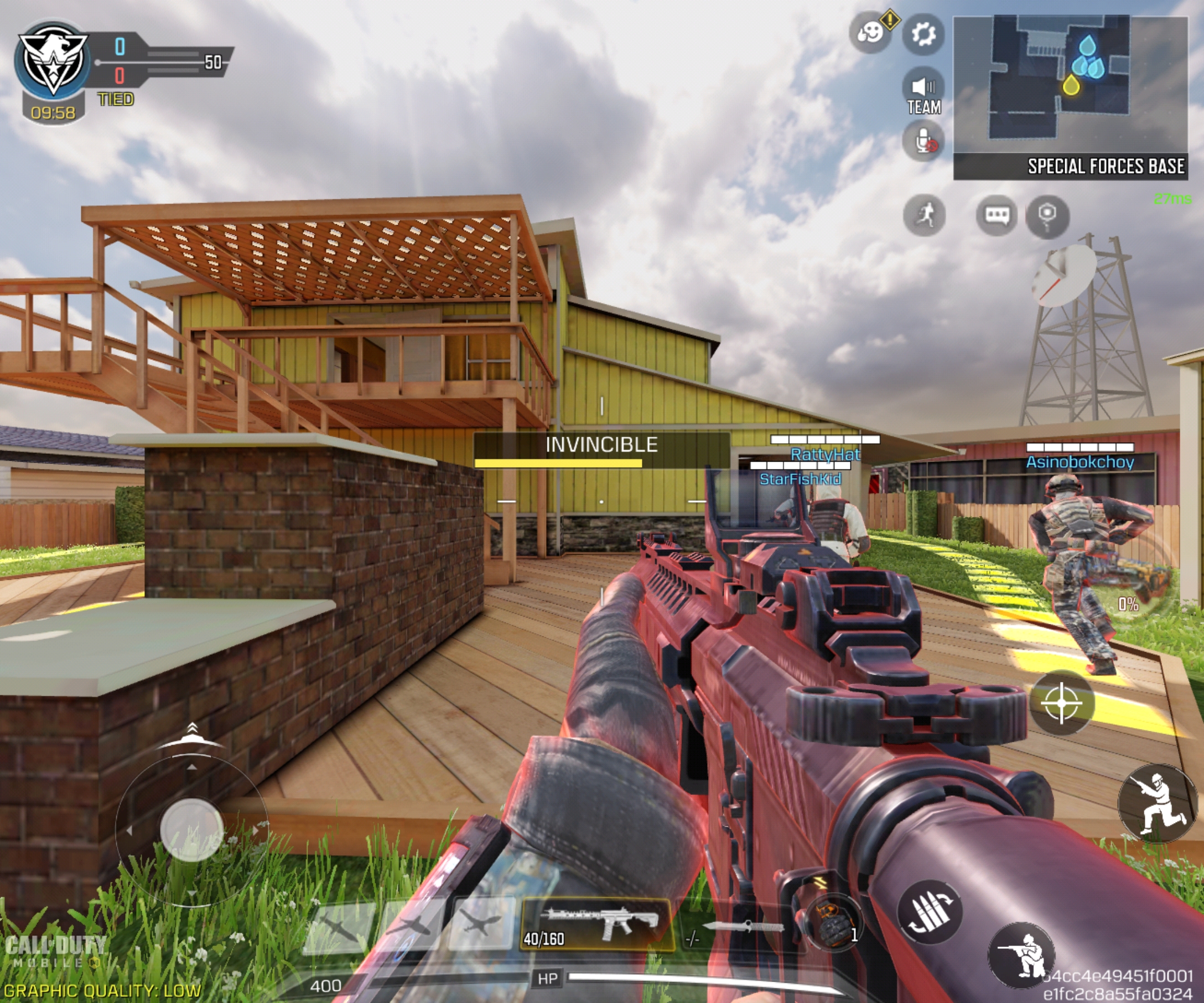
I played Call of Duty Warzone Mobile at the highest image quality and framerate, without any tearing or stuttering and raced through the streets of San Francisco with Asphalt 9: Legends. I also edited multiple 4K video streams at once in PowerDirector (I find that most mobile video editors cannot edit the 8K video). This foldable is ready for pretty much anything.
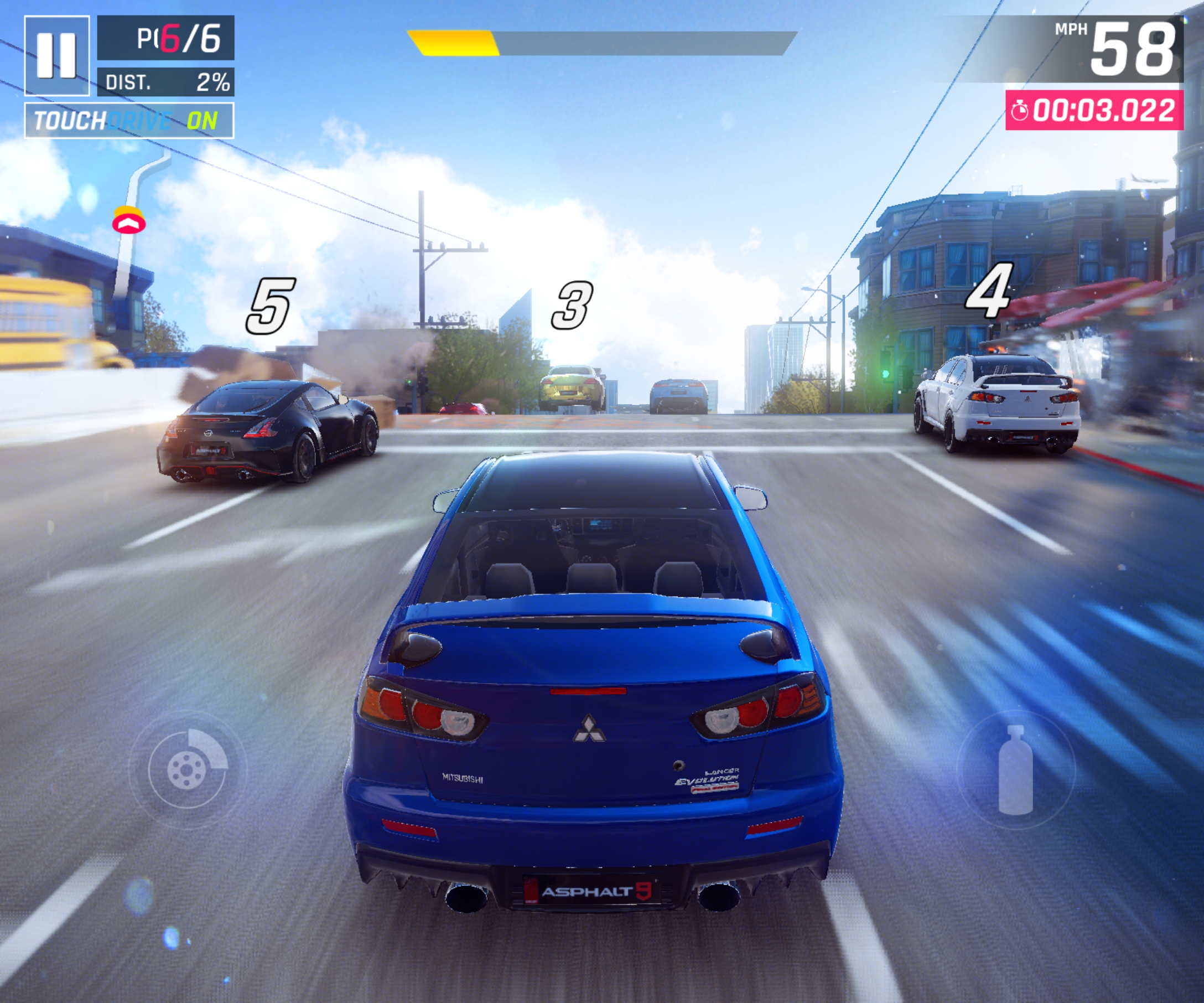
Naturally, this is a 5G phone and, where I had good coverage, I had solid connections and speedy downloads. There is support for both a physical SIM and eSIM. The Wi-Fi 6e support meant excellent office and home performance and means respectable future-proofing.
- Performance score: 4.5 / 5
Samsung Galaxy Z Fold 5 review: Software
- Android 13 w/ One UI 5.1.1
- Much of the software feels expressly designed for a foldable
- Great for multitasking
- Smart use of Flex Mode
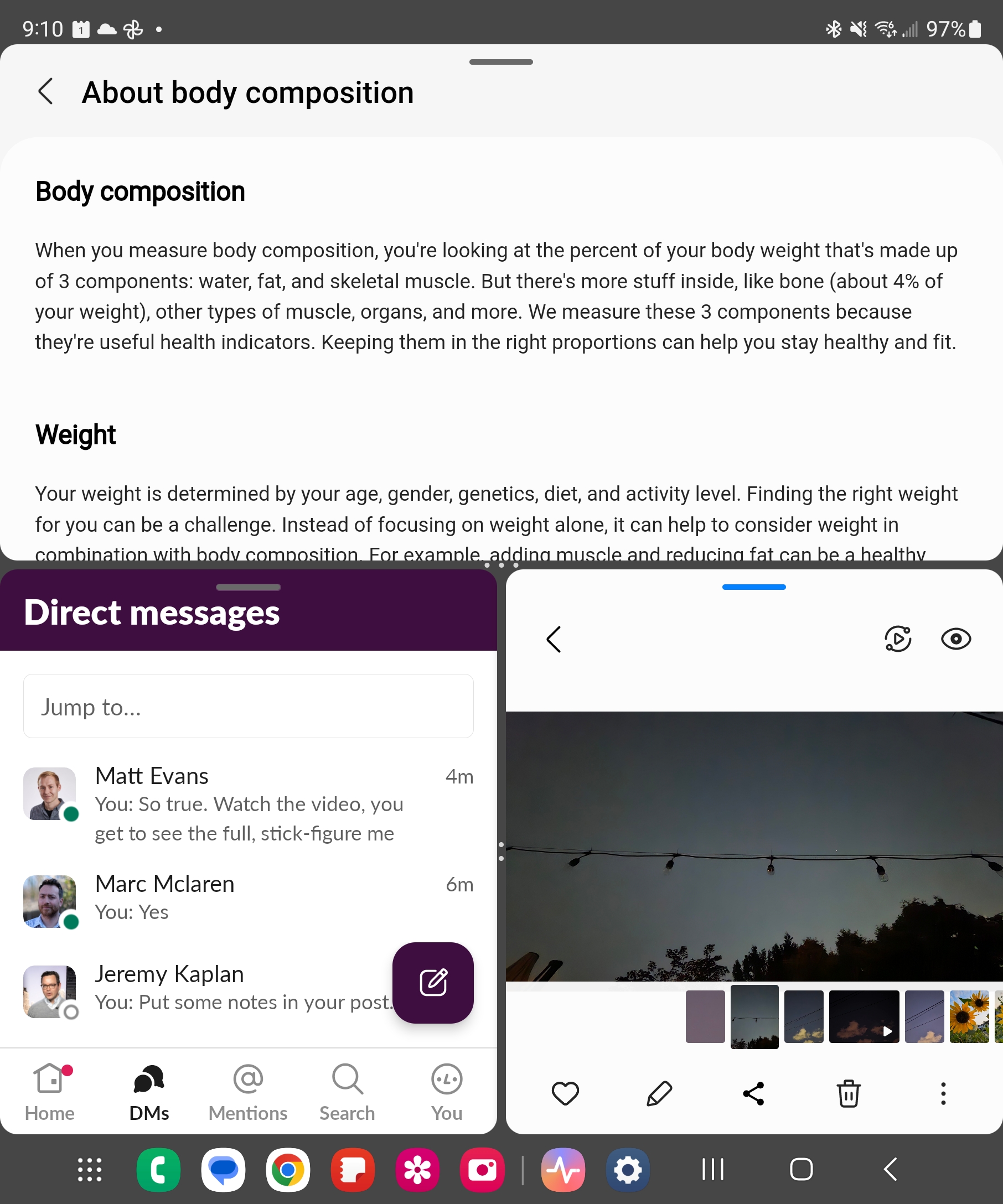
Samsung's foldable runs One UI 5.1.1 atop Android 13. It's a mostly pleasing blend of Google's core Android apps and a handful of Samsung's custom utilities, like Photos, Calendar, and Contacts. As is my habit, I mainly relied on Google tools like Chrome (the default browser in the US is Samsung's own but not everywhere), and Google Calendar.
Samsung has worked closely with Google, though, to build a foldable-friendly platform; one that can effortlessly switch from operations on the smaller cover screen to ones on the larger, flexible screen. When I used Maps in South Korea, I started with the 6.2-inch display but quickly unfolded Z Fold 5 for the more expansive main screen view.
In tablet mode, the taskbar is a perfect companion for opening apps either by tapping or dragging and dropping them into position.
Whether you're on the cover or main folding screen, there's a customizable quick slide-out tray sitting just off-screen on the righthand side. A quick sweep brings it in and you can access often-used apps or tap the grid icon to open a larger app window. It's useful but I admit to usually forgetting it exists.
Samsung hides some features under Labs in settings, because not all apps are designed for multi-app (split-screen use). Similarly, you'll have to dig for the Flex Mode panel controls that let you add on-screen controls when watching videos in Flex Mode (phone bent at around 90 degrees and set on the table). Even after you turn it on, you'll need to select the apps where it appears (it can work, apparently for everything from games to video editors). I honestly don't get the point of hiding useful features like this, even if they don't work perfectly for all apps.
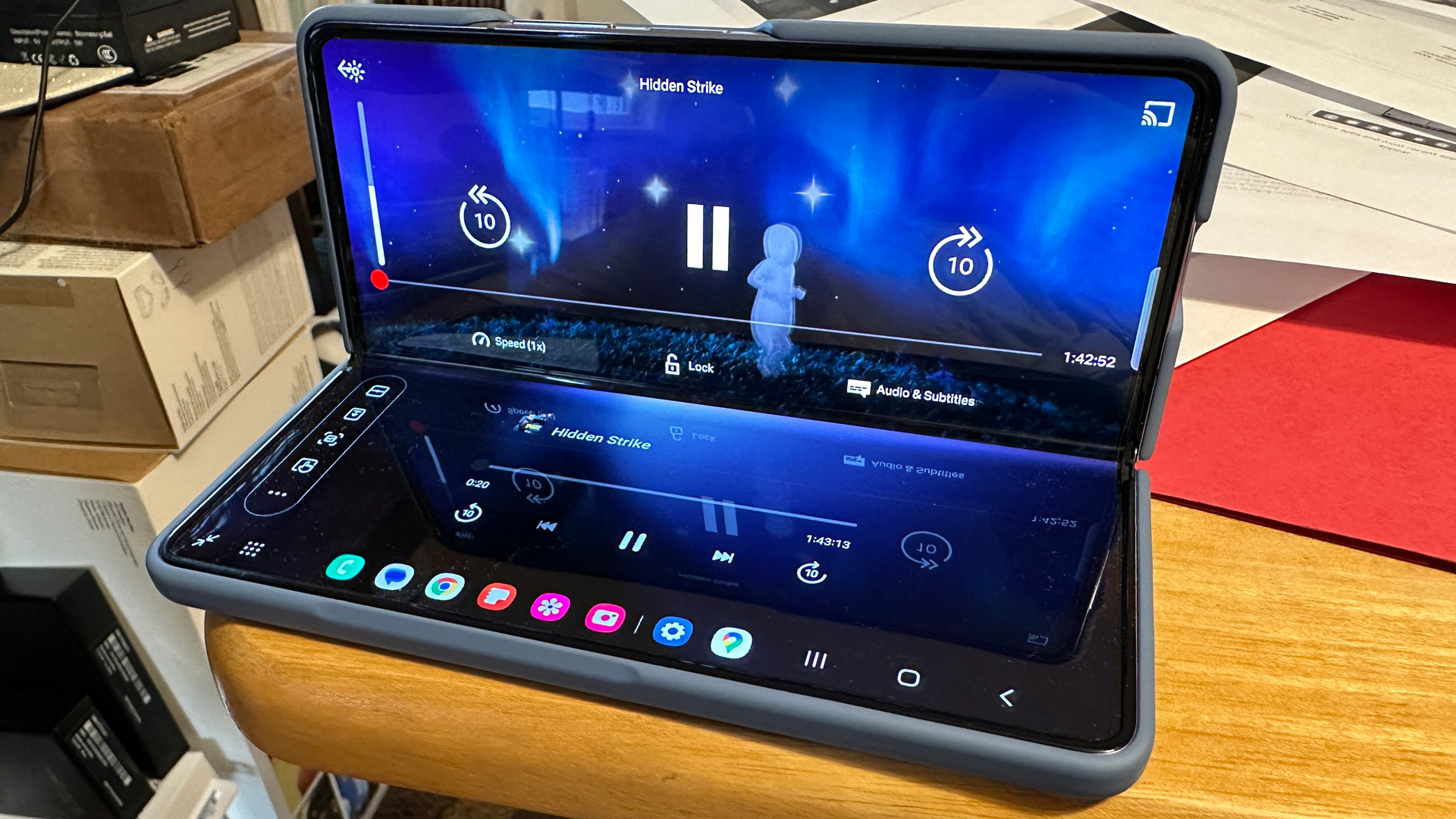
- Software score: 4.5 / 5
Samsung Galaxy Z Fold 5 review: Battery life
- 4,400mAh battery (same as Z Fold 4)
- Lasted all day
- Supply your own power adapter
Samsung kept battery capacity unchanged from the Z Fold 4 to the Z Fold 5. 4,400mAh is smaller than what you'll find on the Pixel Fold, which carries a 4,727mAh battery (and 30 more grams than the Z Fold 5).
Samsung promises all-day battery life, and that's what I consistently got. Most days it was 15 hours of use or more.
The phone supports Samsung's take on 'Super Fast charging', refueling 50% in 30 minutes. In our tests, we recharged to 56% in 30 minutes using a 65W power adapter. There's no charging adapter in the box, however (just the USB-C cable), so if you want the fastest charging speeds, you'll want to pick up one of those compatible 65W or 45W adapters.
I was also able to charge on a variety of Qi wireless chargers. The phone also supports wireless PowerShare, which means – when enabled in Settings – you can place one Samsung phone on top of the other to transfer battery power from one phone to the other (or to earbuds or a supported smartwatch).
- Battery score: 4 / 5
Should I buy the Samsung Galaxy Z Fold 5?
Buy it if...
Don't buy it if...
Samsung Galaxy Z Fold 5 review: also consider
How I tested the Samsung Galaxy Z Fold 5
I started testing the Samsung Galaxy Z Fold 5 in South Korea, taking it on company headquarters and factory tours, basically using the effective camera collection to document everything. I used it for communication with family and friends, as well as work, running Slack and email on it.
I did my best to make it my main phone throughout a week of testing.
A significant part of my testing involved content consumption (movies, websites, podcasts) and even some creation. I drew on it and edited social video.
As I mentioned above, I also used it to help keep me from getting lost in Seoul, South Korea.
I ran benchmarks, as did TechRadar's Mobile Team, and Future labs which combined for my Performance section.







